
Dear Reader,
It’s an honor for the EOG team to introduce such a special issue, where we had the unique opportunity to cover the historic COP27 and the Eighth EOG Convention, which marked the 15th anniversary of EOG and the tenth anniversary of the EOG Committee.
It has been a November to remember for the oil and gas sector as a whole and the Egypt Oil & Gas team in particular. For the first time, the oil and gas sector gets the chance to have its voice heard at the climate summit. Decarbonization Day, which was held on the sidelines of COP27 in Sharm el-Sheikh, was a breakthrough for the oil and gas sector to introduce their decarbonization efforts and plans.
In our issue, we try to analyze the most important outcomes of this historic event and its effects on the oil and gas industry.
The outcomes of COP27 were also on the table of discussions at the eighth EOG Convention which gathered senior and prominent figures of the industry to debate energy security and decarbonization efforts.
This year’s convention has marked two milestones for the EOG team as it witnessed the celebration of the 15th anniversary of Egypt Oil & Gas and 10 years since the foundation of the Egypt Oil & Gas Committee.
Amid the hype of the busy convention, with a variety of discussions, technical sessions, and other activities, it was great to take some time to remember our incredible journey together. It was great to celebrate the exceptional success of EOG in committing to its slogan, “Connecting the Pieces”. On its way to achieving this, it had to weather three downturns, one revolution, and one pandemic. However, with every downturn, we were able to create an opportunity, facing with commitment and determination to be of impact on Egypt’s oil and gas industry. Dear reader, we hope you share with us this pride and happiness about what our industry has been able to achieve in this memorable month.
IHAB SHAARAWY Managing Editor
CONTENTS
Energy Security, Decarbonization Take Centre Stage at 8th EOG Convention

General Manager
AYMAN RADY
Research & Analysis Manager
MAHINAZ EL BAZ Managing Editor
IHAB SHAARAWY
Senior Editors
RANA AL KADY NADER RAMADAN Senior Writer
SARAH SAMIR
Staff Writers
FATMA AHMED ISRAA NOUR ELDEEN
Senior Research Analyst
REHAM GAMAL
Research Analysts
YOUSTINA MOUNIR JOLLY MONSEF
MARIAM AHMED Statistician NADA ABBAS
Chief Reporter WAEL EL-SERAG Business Development Manager TAMARA EWISS Marketing Specialist
SHROUK IHAB Creative Art Director OMAR GHAZAL Art Director MAGED KHATTAB
Graphic Designer MERNA WILLIAM
3D Visualizer TAMER GAMAL
Photographer
HADY NABIL
CEO Executive Assistant NOHA ZAYED Web Master OLFAT KAMEL Web Developer MOHAMED ELWAKEEL
Administration
TAGHREED MOUNIR Senior Accountant
MAHMOUD KHALIL Accountant
MOHAMED NAGY Distribution Officers
MAHSOUB KENZI
MOHAMED EL-SAYED MAHMOUD NABIL OSAMA MOHAMED HESHAM MOHAMED
Publisher
MOHAMED FOUAD
All rights to editorial matters in the newspaper are reserved by Egypt Oil and Gas and no article may be reproduced or transmitted in whole or in part by any means without prior written permission from the publisher.
Tower No.12 - Bavaria Compound, Ring Road in front of sama Tower - Egypt 18 24 22 27 25 26 GAS FLARING IN EGYPT: OPPORTUNITIES AND CHALLENGES PETROLEUM POWERS UP THE GREEN ECONOMY OIL, GAS SECTOR LEADS EGYPT’S DECARBONIZATION JOURNEY DIRECT AIR CAPTURE (DAC): NEW TRACK TOWARDS DECARBONIZED WORLD CARBON NEUTRALITY: THE PENULTIMATE SOLUTION PROUDLY THE OFFICIAL PUBLICATION EFFECTIVE LEGISLATION TO ESCAPE THE GLOBAL ENERGY CRISIS /EgyptOilandGas /EgyptOilandGas /EgyptOilandGas /EgyptOilandGas /Egypt-Oil-&-Gas (+20) 2 27498191 (+20) 2 27498192 (+20) 2 27498190 www.egyptoil-gas.com info@egyptoil-gas.com
EGYPT’S LEADING OIL & GAS MONTHLY PUBLICATION
10 | EGYPT OIL & GAS NEWSPAPER 2
EDITOR’S LETTER


DECEMBER 2022 - ISSUE 192 | 3 www.egyptoil-gas.com
EGYPT, EU SIGN HYDROGEN STRATEGIC PARTNERSHIP MOU
Minister of Petroleum and Mineral Resources Tarek El Molla has participated in the signing of a memorandum of understanding (MoU) with the European Union (EU) for cooperation on green hydrogen and its derivatives production, consumption, and trade.
The MoU was signed on the sidelines of COP27, held in Sharm El Sheikh. It aims to encourage and boost investments in the infrastructure needed for hydrogen distribution, storage, and export as well as generating renewable energy.
Additionally, a joint declaration was signed in the frame of the Nouwfi project to support it with the needed water, food, and energy with EUR 35 million in support.
During his speech, El Molla affirmed this MoU came as one solution developed for securing clean energy resources with zero carbon in the shadow of global energy crises. He noted that hydrogen is one of the best solutions to overcome such crises.
EGYPT TO ACCELERATE ACCESS TO RENEWABLE ENERGY TO 42% OF ENERGY MIX BY 2030: EL MOLLA
Minister of Petroleum and Mineral Resources Tarek El Molla stated that Egypt has a strategy to accelerate access to renewable energy such that its contribution to Egypt’s energy mix will reach 42% by 2030, the ministry said in a statement.
This is a more ambitious strategy compared to previous plans to achieve this goal by 2035, according to El Molla.
His statement came during his participation in the “Net Zero World Initiative” session at COP27, in which El Molla explained that 10 memoranda of understanding (MoUs) were signed for green hydrogen with capacities of up to 50 gigawatts.
It was arranged to replace 28 gigawatts of power stations that operate with fossil fuels to operate with renewable energy during the next few years gradually, El Molla said. He added that with regard to the Zero Emissions Initiative
A BLAST
FROM THE PAST
and the Methane Reduction Pact which Egypt joined, an action plan has been developed for implementation, as work is being done to decarbonize about 120 oil and gas projects as well as recover flare gas.

The minister thanked US Secretary of Energy Jennifer Granholm for inviting him to attend the Net Zero World Initiative for the second time after he attended its launching last year in Glasgow, and Egypt joined it to benefit from the technologies, solutions, and information it provides that contribute to achieving sustainable development.
EGYPT LAUNCHES HYDROGEN STRATEGIC FRAMEWORK
Minister of Petroleum and Mineral Resources Tarek El Molla has announced the launch of the Hydrogen Strategic Framework at COP27, affirming that low-carbon hydrogen is a sustainable tool for energy diversity and finding a flexible energy system.
El Molla elaborated that Egypt has the needed infrastructure to fulfill the increased demand for energy security.
The minister stated also that the announcement of this strategy is a primary step towards achieving Egypt’s vision to have an interactive role in the low carbon hydrogen economy by utilizing its assets and resources of new and renewable energy as well as its strategic location and human cadres.
Moreover, El Molla added that developing the national strategic low hydrogen carbon framework is a model for the distinguished cooperation between the Egyptian ministries and the European Bank for Reconstruction and Development (EBRD). At the end of the meeting, El Molla witnessed the signature of several agreements for green hydrogen production.
EL MOLLA, OPEC SECRETARY GENERAL DISCUSS ENERGY MARKET DEVELOPMENTS AT COP27
Minister of Petroleum and Mineral Resources Tarek El Molla met with OPEC Secretary General Haitham Al Ghais to discuss the developments in energy markets in light of the many global challenges the international community is witnessing today.
At one of many rounds of talks taking place at COP27 in Sharm El Sheikh, El Molla and Al Ghais discussed the outcomes of Decarbonization Day, which the oil and gas industry participated in for the first time as part of the activities of climate summits and conferences.
The meeting emphasized that the oil and gas industry has an important and continuous role in securing energy supplies globally in parallel with the development of renewable energy sources, especially with the availability of solutions using technological means to reduce emissions and remove carbon from all stages of the petroleum industry.
EGYPT, AUSTRALIA EXPLORE COOPERATION IN GREEN HYDROGEN AT COP27
Minister of Petroleum and Mineral Resources Tarek El Molla met with Reece Whitby, Australian Minister of Environment and Climate Action, as part of a series of bilateral meetings he is holding in Sharm El Sheikh, where is attending COP 27.
The meeting discussed ways to increase joint cooperation in the field of mining, energy transformation projects, emissions reduction and green hydrogen production.
During the meeting, El Molla highlighted the need to expedite energy transformation projects, reduce carbon emissions, produce green hydrogen, and rely on modern technology and technology in the field of mining to preserve the environment, especially since Australia has pioneering experiences and advanced technologies and expertise in this vital field.
There are promising opportunities in Egypt in the field of mining after the legislative reforms that have taken place, and it has become an attractive sector for investment, El Molla said, adding that there are actually Australian mining companies working in Egypt, and we look forward to having similar cooperation with Australia in producing green hydrogen in Egypt.
179.1%
On 23 December 2021, President Abdelfattah El Sisi inaugurated the Assiut Gasoline Production complex, a high-octane benzene production facility, which is just one of many strategic projects that aims to boost the development of Upper Egypt.
As the largest petroleum complex in Upper Egypt, this project makes use of advanced technologies in the refining sector, turning low-quality fuel oil (mazut) into high-quality petroleum products in accordance with the EURO 5 standards. The project aimed to secure gasoline supplies for the people of Upper Egypt and save the cost of transporting them from refineries in Cairo.
Egypt’s local production of benzene increased by 55% from about 3.9 million tons in 2014 to 6 million tons in 2021, as a result of three major projects, including the new project in Assiut, the Egyptian Refining Company’s (ERC) Mostorod refinery, and the expansions of the ANRPC plant in Alexandria.
NUMBER OF THE MONTH
Increase in Natural Gas & LNG Exports Value in August 2022 (YoY)
Egypt’s exports value of natural and liquefied natural gas (LNG) jumped to reach $243.2 million in August 2022, as opposed to $87.1 million a year prior, during the same period in 2021, according to Central Agency for Public Mobilization and Statistics (CAPMAS).
This hike in exports came in line with Egypt’s strategy to become a regional gas hub in the Mediterranean, thanks to its strategic location, the available strong infrastructure, and the major gas discoveries it has made.
TOP 5
| EGYPT OIL & GAS NEWSPAPER 4 EGYPT UPDATES
i-Trak drilling automation services
Get safe, efficient, and predictable drilling
performance
i-Trak drilling automation services from Baker Hughes reduce operational risk and well delivery costs by integrating and automating drilling systems.

In today’s complex drilling environment where surface and downhole real-time systems must deliver according to plan in a predictable, efficient, and safe manner, automation of drilling systems is crucial. The drive to reduce HSE risks by moving personnel from wellsite red zones to remote centers is simplified and supported through the integration and automation of drilling systems.
Baker Hughes’s i-Trak drilling automation services improve drilling performance, wellbore quality and trajectory; extend bit life; reduce nonproductive and invisible lost time (NPT, ILT) to deliver wells faster and more economically while reducing operational risk to enable de-manning at the rigsite. These benefits are achieved by aggregating real-time surface and downhole data and annular pressures, and using hybrid physics-based and data-driven models, in combination with automated standardized operating procedures and checklists.
Our i-Trak drilling automation services manage well construction via fully closed loop-control of Baker Hughes rotary steerable assemblies, wellbore
hydraulics, and drilling optimization services.
i-Trak services offers two levels of automated control:
• Advisory mode: recommended actions or parameters are displayed to the driller who can accept or reject them
• Closed-loop mode: parameter changes and instructions are automatically downlinked to downhole tools or transmitted to rig automation platforms to control surface parameters.
In closed-loop mode, the human driller can start/stop the system at any time to make any desired adjustments to the drilling path or operational parameters.
The i-Trak service is a fully integrated extension of Baker Hughes’ digital well planning software and ecosystem. This allows i-Trak to monitor and control drilling and reservoir navigation operations based on a continuously updated digital twin of the reservoir and downhole environment.
Contact your Baker Hughes representative to learn how i-Trak drilling automation services can help you achieve safer, more efficient, and more predictable performance on your next well.
Applications
• Wells with inefficient, or inconsistent or unpredictable drilling performance
• Wells with hole cleaning issues, stability issues, or challenging pressure windows
• Wells that must be consistently and repetitively drilled
• Wells using decision-making remote operations or leveraging integrated operations personnel models
Benefits
• Improved safety, lower risks
- Openhole pressure regime monitoring with automated alerts
- Swab/surge NPT protection
- Reduced personnel risks
• Superior drilling and reservoir navigation efficiency
- Improved hole cleaning
- Optimized tripping speeds
- Guaranteed average-excess dogleg severity limits (AEDLS) <1°/100 ft. (30m)
- Increased hydrocarbon recovery
• Predictable drilling performance
- Increased gross ROP
- Fewer stuck pipe incidents
- Reduced NPT and ILT
bakerhughes.com
DECEMBER 2022 - ISSUE 192 | 5 www.egyptoil-gas.com
Copyright 2020 Baker Hughes Company. All rights reserved. 80390 Rev. 9/2021
EL MOLLA: DECARBONIZATION DAY IDEAL PLATFORM TO PRESENT EFFECTIVE CLIMATE SOLUTIONS
Decarbonization Day was an ideal platform for global organizations, industry stakeholders, and energy companies to discuss and present their commitments, initiatives, and actions to improve the global climate situation, Minister of Petroleum and Mineral Resources Tarek El Molla stated.
El Molla’s comments came as he concluded the activities of Decarbonization Day within the COP27 climate summit with a speech at the closing session, in which he presented a number of important points.
Decarbonization Day, which was held on November 11th, was a wonderful window to present this to the world, and it became clear in the live sessions that both directions must go
in parallel together, that is to provide energy for today and the future to solve the problem of achieving energy security, and at the same time at a reasonable price, saving energy is necessary and indispensable to fulfill human aspirations.
Africa is seeking to enter the energy markets to export its resources, and under the right conditions, Africa can develop resources and achieve development and prosperity to achieve the Millennium Development Goals, but Africa will not do this alone, El Molla said. They need partnerships that can help them with technology, technology transfer, and financing mechanisms as means of growth and allow access to global markets, El Molla explained.
EGAS, SEASPLIT TECHNOLOGIES, GE SIGN MOU TO DECARBONIZE THE GULF OF SUEZ
Minister of Petroleum and Mineral Resources Tarek El Molla witnessed the signing of a memorandum of understanding (MOU) between EGAS, SeaSplit Technologies, and General Electric (GE) to remove industrial carbon from the Gulf of Suez.
The MoU was signed on the sidelines of COP 27 by Magdy Galal, EGAS Chairman; Hussein Mesharafa, CEO of SeaSplit Technologies; and Joseph Anis, President & CEO, Europe, Middle East, and Africa (EMEA), GE Gas Power.
According to the MoU, the three companies plan to assess the technical and economic feasibility of developing 1.5 gigawatts of offshore wind energy in the Gulf of Suez, and intend to discuss the participation of Egyptian petroleum sector
companies in the implementation of the project. This is an unprecedented project in Africa and the Middle East, and it is expected that the electricity generated will operate the offshore oil and gas facilities, and it can also supply the grid with surplus energy.
SAUDI ENERGY MINISTER PRAISES DECARBONIZATION DAY’S ACHIEVEMENTS
Saudi Arabia’s Minister of Energy Abdul Aziz bin Salman said that Decarbonization Day succeeded in emphasizing the petroleum industry’s efforts in sustainable development.
His remarks came during his participation in a panel discussion with Minister of Petroleum and Mineral Resources Tarek El Molla on Decarbonization Day during COP27.
Bin Salman added that this event highlighted the importance of teamwork in supporting and implementing the commitments towards preserving the environment as well as securing energy supplies to meet sustainable development needs.
Additionally, the two ministers explained the extent of coordination and extended cooperation between the two countries under the political leadership of the two countries and their support for green initiatives that the planet deserves.

EGYPTIAN LNG, BECHTEL COALITION SIGN FEASIBILITY STUDY AGREEMENT FOR ELNG ZERO-FLARING SYSTEM

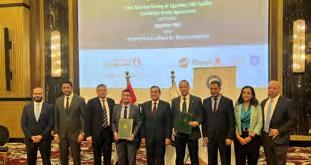
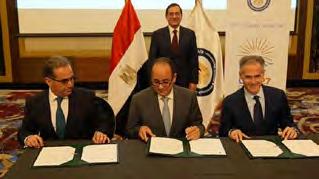
Minister of Petroleum and Mineral Resources Tarek El Molla witnessed the signing of a feasibility study agreement between Egyptian LNG and the Bechtelled Coalition for Decarbonization at COP 27, the ministry said in a statement.
The coalition includes Enppi, Petrojet, Baker Hughes, GE Digital, HSBC, and NBE. The agreement was signed by Mohamed Elbahnasy, President of Egyptian LNG, and Karim El-Dessouky, Bechtel Egypt Country Manager.
The study will evaluate the implementation of a zeroflaring system at the Egyptian LNG export terminal (ELNG) in Idku, according to Bechtel.
According to the agreement, the study will assess total routine flaring recovery options by modifying the existing flare and compression systems at the ELNG facility, reducing methane emissions from this strategic regional facility.
"I am so proud that Egypt’s oil and gas sector is contributing significantly to achieving top strategic goals and priorities: accelerating decarbonization and applying state-of-the-art technologies and solutions in this domain,” El Molla said, adding “I am pleased that the sector is collaborating with our partners to take such initiatives and promote these priorities."
"This initiative is an important part of ELNG’s continuing efforts to deliver operational improvements for our two LNG trains,’’ Elbahnasy commented.
ELNG is a joint venture between Shell, Petronas, EGAS, EGPC and Total Energies.
"This project is a demonstration of our commitment to powering progress by providing more and cleaner energy,” Eng. Khaled Kacem, vice president and country chair of Shell Egypt, noted.
"This project is an excellent example of private and public sector partnership to support Egypt’s decarbonization strategy that will strengthen energy security in the region," Paul Marsden, President of Bechtel Energy commented.
EGYPT, SIEMENS
ENERGY SIGN
CAPACITY BUILDING AGREEMENT FOR DECARBONIZATION AT COP27
Minister of Petroleum and Mineral Resources Tarek El Molla and Siemens Energy CEO Christian Bruch witnessed the signing of an agreement at COP27 between the ministry and the global energy giant for training and building human capacities in the fields of decarbonization.
According to the agreement, Siemens Energy will work with the ministry to provide integrated training programs that combine theoretical and practical knowledge for the cadres of the Young and Middle Management Program, which is a part of the petroleum sector’s Modernization program. This will provide them with the necessary skills to achieve the goals of decarbonization strategies and implement future projects in this field.
The scope of the agreement includes training in the fields of decarbonization and hydrogen, in
addition to practical training at Siemens Energy sites outside of Egypt throughout the year. The governance program for future women will also be presented to a number of female engineering cadres, as well as the technical programs to support the achievement of the objectives of this initiative.
For his part, Wenzel appreciated the Egyptian efforts to organize COP27. He noted that Germany has good experiences as well as the ability to produce ammonia in addition to studying future projects to a diverse source of natural gas.
ENERGY TRANSITION
EL MOLLA PRAISES GERMAN PARTICIPATION AT COP 27
Minister of Petroleum and Mineral Resources Tarek El Molla has praised the participation of the German delegation at COP27 which was held in Egypt.
This came during El Molla’s meeting with German Parliamentary State Secretary for Economic Affairs and Climate Action, Stefan Wenzel on the sidelines of COP27.
Additionally, the minister highlighted the importance of Decarbonization Day was included in the activities of the summit. He also praised the declarations of intent that were announced with Germany to cooperate on hydrogen and liquefied natural gas (LNG).
Moreover, El Molla pointed to the importance of increasing German investments in Egypt in the field of petroleum exploration and production (E&P) to increase production and export the surplus to Europe.
DECARBONIZATION ZERO-FLARING SYSTEM
| EGYPT OIL & GAS NEWSPAPER 6 EGYPT UPDATES
EMISSIONS REDUCTION RENEWABLES
EGAS, SHELL SIGN GHG EMISSIONS REDUCTION MOU
The Egyptian Natural Gas Holding Company (EGAS) signed a memorandum of understanding (MoU) with Shell Egypt with the aim of cooperating in establishing a framework for managing and reducing greenhouse gas emissions from the operations of all EGAS partners.
Minister of Petroleum and Minera Resources, Tarek El Molla, witnessed the MoU signing by Magdy Galal, EGAS Chairman, and Khaled Kacem, Chairman of Shell Egypt.
Commenting on the signing, Kacem, said “We are very proud to cooperate with EGAS in this initiative, especially since Shell has global expertise in reducing greenhouse gas emissions, and has already contributed to several
decarbonization projects in Egypt. We have always been partners with Egypt, and we are committed to supporting the country’s efforts in its path to transform Egypt into a regional energy hub, and its ambitions to decarbonize the petroleum sector.”
The MoU signing came within the framework of COP27 held in Sharm El Sheikh.
EGYPT SIGNS SEVEN MOUS, AGREEMENTS FOR SUSTAINABILITY, EMISSIONS REDUCTION
Minister of Petroleum and Mineral Resources Tarek El Molla witnessed the signing of seven memoranda of understanding (MoUs) and agreements between the oil and gas sector and a number of international companies in the field of sustainability and emissions reduction, during COP27.
El Molla stated that the MoUs came as an extension of the efforts launched by the ministry to enhance the capabilities of the Egyptian oil and gas industry and its capabilities in the field of carbon reduction and environmental sustainability of projects, and to benefit from the best experiences and practices provided by international companies in this field.
One MoU was signed between the Egyptian Natural Gas Holding Company (EGAS) and Shell Egypt with the aim of cooperating in
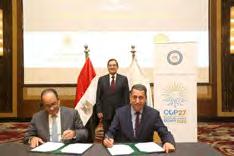
establishing a framework for managing greenhouse gas emissions and reducing greenhouse gas emissions from the operations of all EGAS partners. The MoU was signed by Magdy Galal, EGAS’ Chairman, and Khaled Kacem, President of Shell Egypt.
Another MoU was signed between EGAS, SeaSplit Technologies, and General Electric (GE) to remove industrial carbon from the Gulf of Suez. The MoU was signed by Galal, Hussein Mesharafa, CEO of SeaSplit Technologies; and Joseph Anis, President & CEO, Europe, Middle East, and Africa (EMEA), GE Gas Power. Under the MoU, the three companies plan to assess the technical and economic feasibility of developing 1.5 gigawatts of offshore wind energy in the Gulf of Suez and intend to discuss the participation of Egyptian petroleum sector companies in the implementation of the project.
EGYPT, AIBEL DISCUSS UPGRADING THE MAINTENANCE SYSTEM TO REDUCE EMISSIONS

EL SISI LAUNCHES GLOBAL FORUM ON RENEWABLE HYDROGEN
Egyptian President Abdel Fattah El Sisi announced the launching of the Global Forum on Renewable Hydrogen in partnership with Belgium and a number of international partners.
The forum aims to establish a permanent platform for dialogue for the hydrogen-producing and consuming countries as well as international organizations and the private sector. The announcement comes during El Sisi‘s speech at the
round table “Investing in the Future of Energy: Green Hydrogen”, which was held during COP27 in Sharm ElSheikh.
Green hydrogen comes as one of the most prominent solutions in terms of moving towards a green economy in the coming years, as it represents a real opportunity for economic development in line with efforts to confront climate change and achieve the goals of The Paris Agreement, El Sisi stated.
ELSEWEDY ELECTRIC IN PARTNERSHIP WITH RENEW POWER SIGNS FRAMEWORK AGREEMENT WITH EGYPTIAN GOVERNMENT FOR A GREEN HYDROGEN PROJECT
On the sidelines of COP27, Elsewedy Electric in partnership with ReNew Power Private Limited, a subsidiary of ReNew Energy Global Plc have signed a Framework Agreement with the government of Egypt to jointly develop, finance, construct, operate and maintain a green hydrogen project with its related ancillary facilities, the company said in a statement.
The Framework Agreement is entered into with The Sovereign Fund of Egypt (“TSFE”) Infrastructure & Utilities Sub Fund, New and Renewable
Energy Authority (“NREA”), Egyptian Electricity Transmission Company (“EETC”), and The General Authority for Suez Canal Economic Zone (“SC Zone”). The Project comes in line with Egypt’s National Green Hydrogen Strategy issued during COP27.
Initially, a pilot electrolysis plant is expected to produce 20,000 tons of green hydrogen annually. While for the next phase, the annual output of the plant will be raised by up to 200,000 tons of green hydrogen, bringing the total production to 220,000 tons.
AEP-II REACHES US$336.6M FIRST CLOSE FOR RENEWABLE ENERGY PROJECTS
Alcazar Energy Partners II SLP (SCSp) (“AEP-II”) a Luxembourg domiciled sustainable infrastructure fund focused on utility-scale renewable energy
projects in emerging markets, has achieved a first close of US$336.6m.
This landmark transaction will enable the development and construction of over 2GW of clean energy infrastructure across selected emerging markets. AEP-II aims to achieve a total generation equivalent to powering over one million households and saving c.a. 3.2m tonnes of Greenhouse Gas emissions.
Alcazar Energy Partners II SLP (SCSp) said that it has signed the first
memorandum of understanding (MoU) with the Egyptian government to invest in green hydrogen-based ammonia.
AEP-II added that the facility aims to produce 230,000 tons/ year powered by a dedicated 1GW renewable energy plant. This transaction encouraged a number of European and Asian investment grade off-takers to provide an offtake agreement for the project.
The company stated that it aims to contribute $650 million in mid-market renewable energy investments in addition to allocating $2 billion in foreign direct investments (FDI) in mature markets.
oil and gas industry to actively contribute to decarbonization and environmental preservation efforts.
El Molla stated that upgrading the maintenance system comes on the list of the petroleum sector’s interests due to its effective role in reducing emissions.
During the meeting, El Molla pointed out that the active participation of ministers, global corporate leaders, and heads of international financing institutions in COP27’s Decarbonization Day drove the
For his part, Andersen praised the success of COP27 and the emphasis on the importance of the energy transition while benefiting from new and renewable energy sources.
EL MOLLA: RENEWABLE
ENERGY PROJECTS TO ACCELERATE EGYPT’S
POWER, HYDROGEN EXPORTS
Minister of Petroleum and Mineral Resources Tarek El Molla stated that renewable energy projects will allow Egypt to accelerate its plan to export electricity and hydrogen to Europe within five years, he said in an interview with Bloomberg on the sidelines of COP27.
Egypt plans to send electricity to Cyprus and Greece through a cable passing through the Mediterranean. It also aims to export hydrogen, which can be used as a fuel for power stations.
El Molla added that “there’s a lot of advancement for this connectivity”, elaborating that Egypt is holding talks about implementing this cable. However, there is no information regarding funding the project.
The minister highlighted the wind farm projects that Egypt has entered with UAE’s Masdar, declaring that the electricity generated from the plant will be used locally and would help with the nation’s goals of having 40% of its energy mix be made up of renewables by 2030.
Minister of Petroleum and Mineral Resources Tarek El Molla met with the CEO of Aibel Mads Andersen and a delegation from the company, being a foreign partner with the Egyptian General Petroleum Corporation (EGPC) in the Egyptian Maintenance Company (San Masr).
DECEMBER 2022 - ISSUE 192 | 7 www.egyptoil-gas.com
HONEYWELL
HONEYWELL LOOKS FORWARD TO EXPANDING ITS INVESTMENTS IN EGYPT
Ben Driggs, Honeywell’s President & CEO of Global High Growth Regions, affirmed that his company is looking forward to increasing its investments in Egypt, especially in emissions reduction, digitalization, hydrogen production, and improving energy consumption efficiency.
KUWAIT ENERGY
He made this statement in a meeting with Minister of Petroleum and Mineral Resources Tarek El Molla during Decarbonization Day at COP27.
Driggs and the accompanying delegate praised the success of the summit and Decarbonization
Day. For his part, El Molla stated that working on increasing emission reduction projects within the oil and gas industry will provide new cooperation opportunities with the companies and private sector to come up with modern solutions and technologies in order to achieve these projects.
KUWAIT ENERGY EGYPT SPONSORS PREVENTION, AWARENESS OF BURN INJURIES PROGRAM
Within the framework of continual practices in preserving the environment and climate, Kuwait Energy Egypt sponsored the AMAN GHARIB initiative, two days of intense awareness workshops, on 30-31 October 2022 at Ras Gharib in Red Sea Governorate in partnership with Ahl Masr foundation, Nahdet Baladna Foundation,
SDX
the National Council for Women and Ebad Al Rahman Foundation.
This workshop aims to spread local community awareness on the dangers of burn accidents, how to avoid them and deal with them correctly, as well as how to take all preventive measures at home, in educational institutions, and in different
workplaces. Additionally, the program aims to raise awareness against bullying and violence.
More than 100 beneficiaries were trained on how to deal with fire hazards, first aid methods, and how to act in case of any danger to reduce losses and ensure the safety of Ras Gharib residents. Each participant received a first aid kit in order for any emergency use.
SDX PRODUCTION REACHES 19.3 MMSCF/D BY END OF SEPTEMBER 2022
SDX Energy Plc announced its unaudited financial and operating results for the three and nine months ended 30 September 2022. The company’s oil and gas production recorded 512 barrels per day (b/d) and 19.3 million standard cubic feet per day (mmscf/d), 3,729 barrels of oil equivalent per

SAP
day (boe/d), which is 3% higher than mid-point full-year guidance of 3,480 – 3,795 boe/d.
The company announced a net cash position of $9.4 million, unaudited, as at 30 September 2022. Out of the 14 wells completed across SDX’s

portfolio in the year to date, eight were producing as at 30 September 2022, two were connected to production post period-end and another two will be connected by the end of November 2022.
SAP SIGNAVIO SUPPORTS PETROLEUM SECTOR TO ENHANCE SUSTAINABILITY OF BUSINESS PROCESSES

Alongside COP27 and the success of Decarbonization Day led by Tarek El Molla, Egypt’s Minister of Petroleum and Mineral Resources on 11 November 2022, with keynote addresses of John Kerry, US Special Presidential Envoy for Climate, and Gerd Muller, UNIDO Director General, the Ministry of Petroleum and Mineral Resources highlighted its intent to work on enhancing the
UOG
sustainability of the sector’s business processes within the Ministry’s decarbonization strategy.
For an organization to make a positive change in any sustainability area, be it to reduce emissions or even to change the way they design and sell their products along circular economy models, an organization needs to transform its business
UOG’S ASH-4 PRODUCTION FLOW RATES REACH
United Oil & Gas PLC (UOG) announced that the preliminary tests for its ASH-4 showed that its production flow rates reached 2,101 barrels of oil per day (bbl/d), in addition to 3 million standard cubic feet per day (mmscf/d) from the Alam El Bueib (“AEB”) reservoir on a maximum 40/64" choke.
MASDAR
processes to turn ambitions into real actions and to transform from the current as-is to the desired to-be. SAP Signavio Process Transformation Suite offers an end-to-end solution to manage this transformation in all its dimensions to enable organizations to transform into more sustainable organizations.
2,101 BBL/D
In a statement, the company added that on a reduced, 32/64" choke, which is expected to be more representative of the producing flow rates, the well flowed at 1,325 bbl/d and 1.8 mmscf/d.
UOG said that the well is expected to be tied into the existing facilities and brought on stream in the coming days and the rig will move to drill the fifth well in the company’s development program.
On this occasion, UOG’s CEO, Brian Larkin commented “We are very pleased with the news of the ASH-4 initial well test result. It is expected that the well will be brought onstream in the coming days and will immediately contribute production and revenue for the Company.”
INFINITY
POWER, MASDAR, HASSAN ALLAM SIGN FRAMEWORK
Infinity Power and its consortium partners, Masdar and Hassan Allam Utilities, announced that they have signed a framework agreement with
AGREEMENT
FOR GREEN HYDROGEN PROJECT IN SCZONE
leading Egyptian state-backed organizations for the development of a 2 gigawatt (GW)
green program the Suez Canal Economic Zone (SCZONE).
| EGYPT OIL & GAS NEWSPAPER 8 CORPORATE NEWS
The consortium signed two memoranda of understanding (MoUs) in April with Egyptian entities, related to the development of two green hydrogen production plants in the country, one in the SCZONE and the other in the Mediterranean. The consortium is targeting an electrolyzer capacity of 4 gigawatts (GW) by 2030, and an
ROSNEFT
output of up to 480,000 tonnes of green hydrogen per year.
The agreement was signed in the presence of Mohamed Shaker, Egypt’s Minister of Electricity and Renewable Energy; Hala Al-Said, Egyptian Minister of Planning and Economic Development; and Sultan Al Jaber, UAE Minister of Industry and
Advanced Technology, UAE Special Envoy for Climate, and Chairman of Masdar, on the sidelines of the 2022 United Nations Climate Change Conference (COP27). The agreement was signed by Mohamed Mansour on behalf of Infinity Power Holding, Mohamed Jameel Al Ramahi on behalf of Masdar, Amr Allam on behalf of Hassan Allam Utilities.
ROSNEFT COMPLETES ACQUISITION OF 37.5% SHARE IN GERMAN PCK REFINERY
In order to acquire Shell’s 37.5% part of the PCK (Schwedt) refinery, Rosneft used its pre-emption right. Relevant notifications have been shared with the partner. The transaction is subject to government and regulatory approvals.
ENI

ENI, TOTALENERGIES
INK
Rosneft will increase its ownership of PCK from 54.17% to 91.67% as a result of the acquisition.
Rosneft Chief Executive Officer Igor Sechin noted: “Increasing the share of PCK refinery is testament to the strategic importance of the
German market for Rosneft. The Company builds long-term relationships with its German partners, provides timely and uninterrupted crude supplies, and modernizes key refinery units.
AGREEMENT ON MARITIME BORDER LINE BETWEEN ISRAEL, LEBANON
A framework agreement between TotalEnergies and its partner Eni and Israel was inked in order to implement the maritime border agreement that Israel and Lebanon.
Together with its partner Eni, TotalEnergies operates exploration block 9 in Lebanon and owns a 60% stake.
Following the signing of this framework agreement, the partners in Block 9 will start exploring a potential that has previously been discovered and may extend into both Block 9 and Israeli seas to the south of the recently formed Maritime Border Line.
The mobilization of the teams, the acquisition of necessary tools, and the acquisition of a drilling rig are the first steps in the preparation of exploration activities.

DECEMBER 2022 - ISSUE 192 | 9 www.egyptoil-gas.com
ENERGY SECURITY, DECARBONIZATION TAKE CENTRE STAGE AT 8TH EOG CONVENTION

Following a productive COP27, the 8th Egypt Oil & Gas (EOG) Convention (November 27-29) came to crown the success of the global climate summit by uniting Egypt’s energy sector in discussing solutions to accelerating the implementation of decarbonization, digitalization, and energy security.
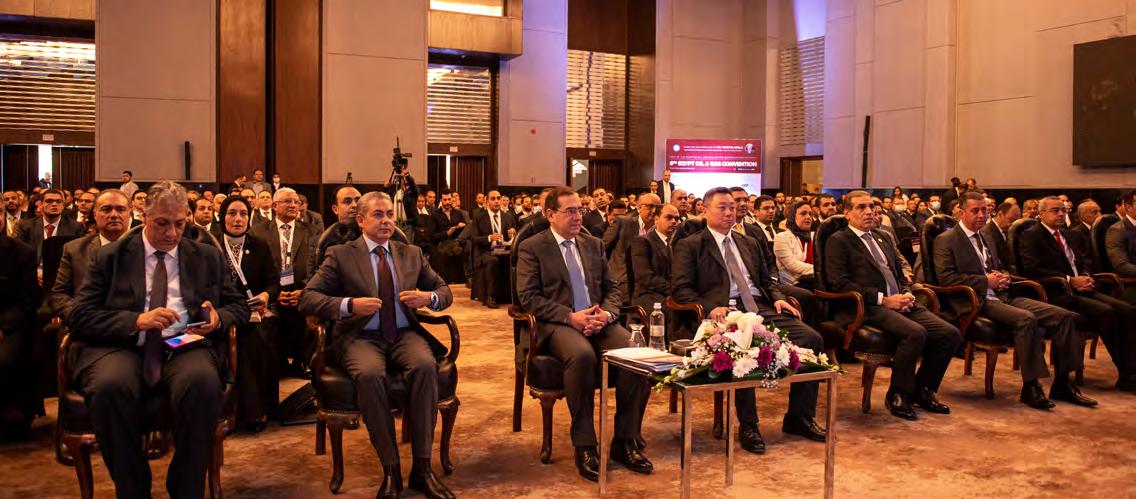
This year’s convention came with 2 milestones as it celebrated 15 years of the establishment of EOG and 10 years of the EOG committee.
The elaborate opening of the convention took place at Dusit Thani Hotel and was launched by Minister of Petroleum and Mineral Resources Tarek El Molla, who highlighted the importance of this occasion in his opening speech. "I think it is a good opportunity for us during these three days to cover all the good ideas that we have already set and identified. What we need to work on together is how we can accelerate the implementation."
El Molla stated that the petroleum sector's successes came from cooperation, interdependence, and teamwork on an integrated program in partnership between the sector’s entities with the state, the private sector and international companies, with the full support of President Abdel Fattah El Sisi, the government and everyone’s belief in the message, vision and cooperation together.


The Minster congratulated EOG and its team on the occasion of its 15th anniversary and the tenth
anniversary of the EOG Committee hailing their efforts in bringing the industry's stakeholders together. "Today we are celebrating the 8 th convention of Egypt Oil & Gas, so, I am very happy to see the progress of this marketing arm that we have decided together to consider as part of our organization in order to make the bridge between the ministry and the state corporations together with our partners, the private and international community."
Adding to his remarks, Mohamed Fouad, EOG CEO and Committee Co-Chairman, also had an inspirational opening speech, pointing out that the focus of the convention is to showcase the efforts of the oil and gas industry in COP 27 and how our industry is able to contribute and support climate change. He further highlighted the role of Egypt Oil & Gas Group and the EOG Committee in the sector since their establishment, affirming their continuous support for the industry. "In the last 15 years, we were able to position ourselves as much more than just a monthly publication, we’ve supported in creating strategies, and initiatives, and presented our industry efforts globally in the format it needs to be shown in. We worked
to make an impact! And this will continue to our main goal."
For his part, David Chi, Vice President and Country Manager of Apache Corporation, EOG Committee Chairman appreciated the support of the minister to EOG committee efforts. “All of us know that we live in a very dynamic and complex world, and one of the biggest challenges humanity faces today is how we produce more energy in order to meet the ever-growing energy demand while doing so in a very responsible, reliable, and affordable manner and that it is the key frame of today’s convention.”
and Mineral
❝ What we need to work on together is how we can accelerate the implementation of decarbonizing our operations . ❞
Minister of Petroleum
Resources Tarek El Molla
ORGANIZED BY OFFICIAL RESEARCH PARTNER TECHNICALLY PREPARED BY SUPPORTING ORGANIZATION | EGYPT OIL & GAS NEWSPAPER 10
OPENING EOGC'22
AWARDS
AWARDS OF EXCELLENCE
The first day of Egypt Oil & Gas' 8th Convention witnessed handing of the Excellence Awards sponsored by Dragon Oil in three categories, Corporate Social Responsibility (CSR), Operational Excellence in Brownfield, and the Decarbonization Award.
Ministry of Petroleum, Egyptian Natural Gas Holding Company (EGAS)/IEOC was awarded the Best CSR Project Award for Zohr Technology School's success story. Meanwhile, Kuwait Energy Egypt was the runner-up for the best CSR project award for Maternal and Child Unit Clinics in Ras Gharib.
Additionally, WEPCO was awarded the Operational Excellence in Brownfield Award. The award was granted for Maximizing Reserve & Production by 600% of BED-1 Brown Field in Western Desert, Egypt. Meanwhile, Kuwait Energy Egypt was a runnerup for the best Brownfield award for Comprehensive Strategy handling challenging old brownfields and loose integrity wells in the Eastern Desert and maximizing its potential via operationally standardized new innovative solutions.
Moreover, Apache was awarded the Decarbonization Award for Achieving an Ambitious Goal of Reducing Upstream Routine Flaring by 40% in its Egyptian Operations.





Meanwhile, Agiba Petroleum Company was the runner-up for the Decarbonization award for Connecting the wells via overhead transmission lines (OHTL) supplied from Meleiha oil plant power generation turbines.

The awards were given to the winning companies’ representatives by H.E. El Molla in a ceremony that was a part of the convention.
ASK THE MINISTER: EOG’S LIVE INTERVIEW WITH TAREK EL MOLLA
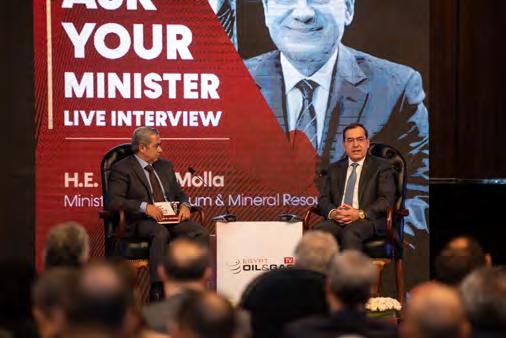
The first day of the 8th Egypt Oil & Gas Convention featured a live interview with Minister of Petroleum and Mineral Resources Tarek El Molla who shared the key developments in the oil and gas industry, especially after the success of COP27. The live interview was conducted by Mohamed Fouad, Founder and CEO of Egypt Oil & Gas, and for the first time members of the petroleum sector had the exclusive opportunity to engage with El Molla by submitting their questions on social media platforms.
El Molla talked about the role that Egypt and the East Mediterranean Gas Forum (EMGF) countries are looking forward to playing regarding the European Union (EU)'s energy needs, in the mid to long-term. The minister started explaining the oil and gas sector's Modernization Project, which began in 2016, in which one of the pillars was to make Egypt a regional energy hub, specifically in terms of oil and gas. Egypt worked on several levels to enable this regional hub vision as it solved arbitration disputes, re-operated liquefaction plants, and managed to shift from an importer to an exporter of gas by enhancing production through existing or new exploration projects.
“Egypt has sought to export natural gas to Europe since 2016, before Zohr production, and resolved arbitration issues because the country had ambition plan and vision to be implemented,” El Molla noted.
The minister further talked about the Middle Management program, which is an important pillar of the Modernization project. El Molla highlighted having a database of all the sector's capabilities and talents to refer to when needed. The minister stated that the sector's success is in unity, not in having scattered teams.
The Middle Management program aims to help potential talents gain experience and skills, and the ministry agreed with corporate leaders to be the participants in the program and put them in executive programs, not only traditional training programs in classrooms, but on-job-training, El Molla explained.
The minister further talked about the digitalization program, and how it helps ensure the safety of oil and gas operations. El Molla said that in the oil and gas sector you cannot develop without becoming strong in safety, and this will not be achieved without science. In the past six to seven years, around $1.2 trillion were invested in the oil and gas sector in Egypt, El Molla stated, referring to the role of middle management, and health, safety & environment (HSE) investments in the past years, which are considered as change agents in the sector.
El Molla also talked about the success of the Egypt Upstream Gateway as a part of the sector's digitalization and modernization. “All Egyptian petroleum companies had subscribed to EUG which is one of the significant success stories of the sector digitalization and there are some countries that started to follow our footsteps,” the minister noted.
DECEMBER 2022 - ISSUE 192 | 11 www.egyptoil-gas.com
ENERGY TRANSITION, DECARBONIZATION DOMINATE THE DISCUSSION AT EOG’S ROUNDTABLE

During the first day of the 8th Egypt Oil & Gas (EOG) convention, a roundtable discussion debated the importance of decarbonization and the ways to secure stable access to energy sources on a timely, sustainable and affordable basis amid the climate change challenges as well as markets instability due to Russian–Ukrainian war consequences.
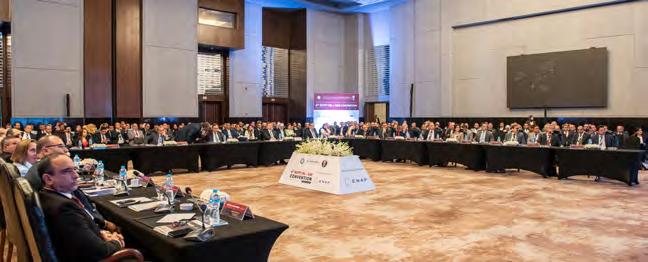
The roundtable was chaired by the Minister of Petroleum and Mineral Resources Tarek El Molla and attended by ministry senior officials, chairmen of holding companies, in addition to leaders of international oil companies (IOCs) operating in Egypt. It was opened by Mohamed Fouad, EOG Committee CEO and Co-Chairman, and moderated by David Chi, Vice President and Country Manager of Apache Corporation, EOG Committee Chairman.
In his remarks, Chi highlighted the importance of increasing oil production in a responsible way, noting the progress of the Egyptian petroleum ministry in this regard.

Denisse Abudinén, CEO and General Manager of ENAP Sipetrol Egypt, stated that Egypt needs to diversify its energy matrix more, mentioning the active role of her company in Egypt. “In order to continue developing the oil and gas industry [in Egypt], we continue increasing the digitization in the industry, also we need to increase innovation,” she said.
For his part, Asharaf Farag, First Undersecretary for Agreements and Exploration at the Ministry of Petroleum and Mineral Resources, outlined the remarkable achievements of the government in energy security since 2015. “We announced around 128 blocks in 12 bid rounds and we signed 140 agreements with a minimum financial commitment of $24 billion and a signature bonus of $1.53 billion,” Farag said.
Khaled Kacem Chairman and Managing Director, Shell Egypt NV, stated that energy security should not impact energy transition as it is part of energy security solutions. “I believe that we are all responsible for supplying the world with the energy it needs right now while building the energy system for the future,” Kacem added.
Ahmed Khalifa, Undersecretary for Projects, Ministry of Petroleum and Mineral Resources, underlined that the existing sources of energy will continue even in the transition period, adding “in parallel, we should [implement] decarbonization".
Also, Sameh Sabry, Senior Vice President and Managing Director of Wintershall Dea Egypt, highlighted the pivotal role of Egypt in energy security within the region. “Egypt has everything [to be energy hub]; the potential resources, infrastructure as well as excellent ties to the region’s countries.”
Sherif Bayoumy, SLB’s Managing Director for Egypt, Sudan and the East Mediterranean, highlighted the role of Egypt Upstream Gateway (EUG) platform in attracting more investors by using the data noting that “data is not only [saving] time, but also it develops a lot of insights and it is important in terms of decision-making".
From his side, Ahmed Helmy, Halliburton North Africa Vice President, discussed his company’s efforts to support the Egyptian market with the needed technologies at such a critical time. "The good thing here for us is we have the right human CAPEX on the ground, where we can create this collaboration and understanding of the challenges with the majority of the customers in order to increase the production in Egypt," he said.
Tameer Nasser, Managing Director and General Manager for Egypt & Sudan at Baker Hughes, stressed that natural gas is part of the energy transition. He shed the light on the Bechtel-led Coalition for Decarbonization which his company is taking part in to support emissions reduction efforts.
Meanwhile, Eleanor Rowley, Managing Director of Capricorn Energy Egypt, pointed out that Egypt is an attractive market to her company. “We came in with the belief that Egypt is a good place to play for growing forward,” Rowley said that the reason behind this is the good trust and confidence between the different companies and the government authorities.
❝
I am very proud that we are all together here as one team, one family, one industry, under one roof, but believe me, with what Wood Mackenzie had shown us in the presentation... that give you the reassurance of Egypt's position, Egypt's potential locally, domestically, regionally, plus the future of oil and gas globally. ❞
Minister of Petroleum and Mineral Resources Tarek El Molla

downstream with the available skilled workforce, robust infrastructure and low cost compared to countries around us in the Arab Gulf, Southeast Asia, and Europe.
Alexandra Thomas, Manager Director Egypt –Neptune Energy, stressed that exploration is key to energy security and energy transition and how enabling technology is important for exploration in Egypt.
During the roundtable, El Molla highlighted the importance of the ongoing dialogue between the petroleum sector and its global partners to discuss common priorities to meet the current global challenges and changes. The priorities are energy efficiency and securing its supplies through increasing low-carbon production.
"I am very proud that we are all together here as one team, one family, one industry, under one roof, but believe me, with what Wood Mackenzie had shown us in the presentation... that give you the reassurance of Egypt's position, Egypt's potential locally, domestically, regionally, plus the future of oil and gas globally, El Molla said.
Tawfik Diab, Chairman of Cheiron Petroleum Corporation, pointed out that the world energy map is changing very quickly and very rapidly and this is putting a lot of pressure on companies, particularly companies of medium size that face a lot of issues relating to financing and costs, as one of the biggest challenges that exist is that there are a lot of interesting opportunities that are too small for the big companies and too big for the small companies.
El Molla stated that there is an agreement to support the joint vision to achieve success in the energy transition phase. He further highlighted that natural gas is a basic option for the transition as well as the importance of using technology to reduce emissions from industrial activities as part of a joint roadmap for implementation.
Layla El Hares, Managing Director of Siemens Energy Egypt, said that the location of Egypt enables it to have a major role in energy security. She emphasized her company’s plans in investing in renewable energy projects in Egypt, noting the importance of natural gas in this regard. “I spoke about renewables in the near future, but this will require a base load of gas,” El Hares stressed.
Mahmoud Dabbous, Chairman & CEO of IPR Energy Group, emphasized that Egypt’s geographically and geopolitically stable position, as well as its strong industry and cultural history of the petroleum sector, can help in building a profitable business environment. He added that it will also boost efforts to diversify investment opportunities, upstream and
Minister of Petroleum and Mineral Resources Tarek El Molla concluded by emphasizing the necessity to go beyond just theories, adding that proposals should be discussed and promptly implemented.
ROUND TABLE
| EGYPT OIL & GAS NEWSPAPER 12 EOGC'22
WOOD MACKENZIE
WOOD MACKENZIE'S INSIGHTFUL PRESENTATION ON ENERGY SECURITY
the emissions that we have today, it doesn’t matter in which sector you are…. Two, we need to capture carbon.”
Capture carbon was just the point that the second panel discussion, titled “Carbon Capture and Storage Opportunities in Egypt,” addressed. It was moderated by Nihal AbdelKarim, Development Engineering Manager at IEOC, and witnessed the participation of Energean Egypt Country Manager Nicolas Katcharov, IOGP Energy Transition Director Concetto Fischetti, SLB Managing Director Egypt and East- Mediterranean Sherif Bayoumy, Wintershall Dea Egypt's Managing Director and Senior Vice President Sameh Sabry, and Egyptian Natural Gas Holding Company (EGAS) Vice Chairman for Energy Transition and Sustainability Samir ElKareish.
The first day of the Egypt Oil & Gas (EOG) convention witnessed a remarkable presentation prepared by Wood Mackenzie giving insights on global energy security considering the Russian –Ukrainian crisis. The presentation was introduced by Martijn Murphy, a Principal Analyst of upstream North Africa at Wood Mackenzie under the title “Global energy Security: What do the current crises mean for Egypt?”.
The presentation provided data about current oil and gas current production as well as expected production. The data showed that the current liquid production reached 100 million barrels per day (mmbl/d), while natural gas production recorded more than 350 billion cubic standard feet per day (bcsf/d) in 2022.
According to Wood Mackenzie, the global liquid production capacity will reach 117 mmbl/d in 2033. Murphy said that gas production is not expected to reach the peak until 240 and it needs more new investments due to its importance in the energy transition process.
PANEL DISCUSSIONS
He showcased the situation of the global oil and gas market after the Russian-Ukrainian war. Murphy said that 1.7 mmbl/d of Russian oil production would be lost in the medium term. So that Wood Mackenzie expects that by 2025, the production growth would come from non –OPEC countries.
The Analyst referred to the role of Egypt and the East Mediterranean region to supply natural gas to Europe to compensate for Russian supplies. According to the data, Egypt has the most volume of prospective resources (2U) in the region. He expects the new terms adopted by the Egyptian government to increase oil reserves to 510 million barrels (mmbl) and facilitate additional investments of $5.8 million. Murphy said that “oil and gas will continue to dominate Egypt’s energy mix in the coming decades”. Additionally, he indicates that Egypt has great potential for renewables.
For ElKareish’s part, one of the main obstacles that the industry faces today is fiscal challenges, which are proving to be a hindrance to carbon capture & storage (CCS). "The main challenges facing CCS, in particular in NOCs, is financing."
As for Fischetti, cooperation between state and private corporations is really at the center of what needs to be accomplished in order to realize tangible results. "CCS is a private-public collaboration where everyone should do his own part, starting from the oil and gas companies."
CONVENTION PANELS GENERATE DECARBONIZATION ROADMAPS
For Wintershall Dea’s Sameh Sabry, technology and awareness are really the fundamental pillars for a successful CCS strategy. "What [we] need to move on now is to increase knowledge on the latest technology, not only the technology but also the whole framework,” Sabry said.
SLB’s Sherif Bayoumy was also quick to point out that even with the right technology available, a roadmap needs to be finalized to set a framework. "I think technology is there, and we should all set and have a roadmap for Egypt with ground rules, for these projects are quite CAPEX-intense, quite budget-intense."
The first day of the 8th EOG Convention witnessed engaging panel discussions, sponsored by Halliburton, titled “Oil & Gas Sector Decarbonization Pathways” and “Carbon Capture and Storage Opportunities in Egypt”.





“Oil & Gas Sector Decarbonization Pathways” was moderated by Layla El Hares, Managing Director at Siemens Energy, and witnessed the participation of EOG Committee Chairman David Chi, Vice President and Country ManagerApache Corporation, Undersecretary for Projects Ministry of Petroleum & Mineral Resources Ahmed Khalifa, Cheiron Petroleum Corporation CEO Dave Thomas, and Tameer Nasser, Director and General Manager Egypt & Sudan - Baker Hughes. One of the main points of this discussion was the importance of gas in decarbonization and the
various approaches that should be used in Egypt to ensure emissions reduction.
Nasser stressed that technology plays an integral part in guaranteeing a positive impact such that the energy sector can remain fully committed to minimizing harmful emissions. "Technology has to be accelerated, there is no doubt about that.”
During his part of the panel, Chi emphasized that decarbonization is an initiative that all economic sectors need to be involved in. “To get to a net zero by 2050 or earlier, one, we have to reduce
Apart from roadmaps, the legal framework also needs to be put in place and according to Energean’s Katcharov, this is already in progress. “EGAS, EGPC and the government are probably working on [carbon storage] regulations. This is probably an opportunity because by experience I can tell you that regulations in Egypt are much faster than in Europe. If there is a business for (carbon storage), then the regulation will come very quickly. "
DECEMBER 2022 - ISSUE 192 | 13 www.egyptoil-gas.com
TECHNICAL SESSIONS EOGC'22
Never has the energy sector faced as many challenges as it is today. With the outbreak of conflict between Russia and Ukraine combined with pressing global warming concerns, the industry’s greatest minds have been hard at work in coming up with solutions to ensure that the sector can sustain profitable growth while remaining committed to its net-zero objectives. Those who had the pleasure of attending the 8th EOG Convention enjoyed the unique opportunity of participating in this event’s technical sessions, which featured a wide variety of speakers, presentations, and revealing case studies. This year at the convention, EOG brings the latest developments that are happening all over the industry.
KEY TRENDS IN DECARBONIZATION TECHNOLOGIES
The first technical session of the 8th Egypt Oil & Gas Convention featured six presentations discussing the key trends in decarbonization technologies.
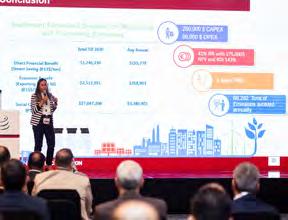

During the session, Mohamed Kamal Gaber, Senior Process & Pipeline Design Engineer at Petrojet, gave a presentation titled “Flared Gas Recovery”, featuring a successful case study from Petrojet. The presentation introduced the definition of flare gas, why it is necessary to cut flare gas, and concluded by the successful case study from Petrojet.
Meanwhile, Mohamed Ibrahim from GUPCO, made a presentation on the roadmap for oil and gas operations greenhouse gas emissions neutrality in GUPCO Ras Shukier onshore field. The presentation discussed how the whole world is going toward green and carbon neutrality very quickly after COVID19, and how the oil and gas sector in Egypt is targeting zero carbon emissions
at some targets, Ibrahim further discussed the six projects GUPCO Ras Shukier’s plan to become carbon neutral.
Additionally, Yosr Omar, ESG Business Development Manager at NESR, talked about how harvesting geothermal energy from produced reservoir fluids eliminates emissions from production capacity operations. It tackled what other sources of power can be generated. Yosry further discussed harvesting geothermal energy, using it as electricity, how it reduces emissions, and introducing new technology to the power market.
Then Radwa Mourad Tman, Senior PhD Chemical Engineer at GUPCO, made a presentation on flare system optimization and emissions control. The presentation discussed why reducing carbon emissions is necessary immediately, highlighting the current technologies that are used to calculate
EFFICIENCY IN OPERATIONS
The second technical session of Egypt Oil & Gas' 8 th convention featured three presentations discussing Efficiency in operations.

During the session, Mahmoud Sayed, Senior Specialist Production Technology at Kuwait Energy Egypt (KEE), gave a presentation entitled 'Challenging of Maximizing Brown Field Production



in High Artificial Lift Failures Frequency Environment as a Result of Wells Harsh Conditions.' The presentation introduces the AREA-A wells' nature and challenges, explaining sand production challenges, approaches and solutions. Sayed discussed the high conductivity reservoir challenges, oversized sucker rod pumps, KEE
the emissions and how the rebel effect technology that they are using is depending on heat value and exit velocity of the flare itself and of the fuel gas.

Additionally, Ehab Mohamed from ENAP talked about flared gas utilization power generation for remote oil fields, zero flaring eventually pays off. It tackled how ENAP is committed to achieving zero flare emissions. Ehab further explained ENAP’S way to achieve zero flaring and the economic benefit of the project.
Finally, Waleed El Sabe, Principal Mechanical Engineer at Enppi, made a presentation on energy efficiency and decarbonization solutions for oil and gas projects using the ORC system. It tackled Enppni’s efforts in energy-efficient solutions, the organic ranking cycle technology, and its application in the Dahshur gas plant.
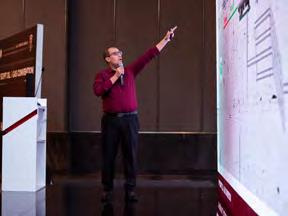
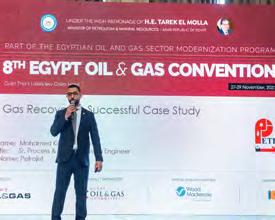
controlling failures frequency methodology, and approaches.
Meanwhile, Ehab Ahmed Abd ElHamid, Facilities and Maintenance Manager at PetroNefertiti Oil Company, gave a presentation on the economic and environmental impact of using flared gas and fuel, featuring a case study from PetroNefertiti Oil
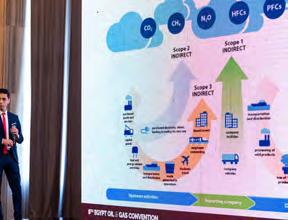
EOG CONVENTION TECHNICAL SESSIONS: PUSHING THE BOUNDARIES OF INNOVATION | EGYPT OIL & GAS NEWSPAPER 14
Company. The presentation discussed how to stop the gas flare and reduce carbon emissions, explaining how to use the available resources to switch the fuel type from diesel to gas. Abd ElHamid talked about using the power system for remote areas that are far away from the national grid. The presentation tackled assuring the sustainability of the project and the ability to apply this project in greenfields or brownfields.
Additionally, Tarek ElShennawy, Manager of Electrical Engineering Sector & Energy Manager at the Alexandria National Refining & Petrochemicals Company (ANRPC), talked about the variable speed drives (VSDs) for energy saving in pump and fan applications. The presentation featured a case study for VSDs in a refinery. It tackled energy appraisal and economic analysis. ElShennawy further discussed the advantages and limitations of VSDs in his presentation.

ASSET INTEGRITY CHALLENGES & OPPORTUNITIES
All over the world, assets have to deal with all types of challenges. These obstacles not only stand as a threat to energy security but also have severe effects on profits and production. For this reason, asset integrity is an integral part of how the petroleum sector can work more efficiently. The issue has been a subject of deep discussion among oil and gas experts for many years. During the second day of the 8th Egypt Oil & Gas Convention, asset integrity was the specific of the event’s third technical session titled "Asset Integrity Challenges & Opportunities”.
The session witnessed four presentations, the first of which was “Structural Aspects of GUPCO Well Integrity Management System” by Mohamed Mostafa Ashraf, who is the Petroleum Engineering Section Head at Gulf of Suez Petroleum Company (GUPCO).

It was followed by yet another informative presentation by Halliburton’s Wael Korosh titled “Successful Transition from A Legacy Well Integrity Management
System to an Integrated, Expandable Platform”. As the company’s Drilling and Completions Advisor, Korosh discussed a number of innovative ideas that interested and engaged the audience.
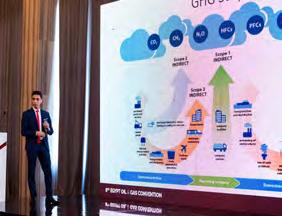


For the session’s third presentation titled “Assessing the Impact Risk of Gathering New Sour Gas Wells with Original Sweet Ones”, Mohamed Abouhashem, Senior HSE Engineer at Belayim Petroleum Company (Petrobel) talked about an interesting and inspirational field case study.

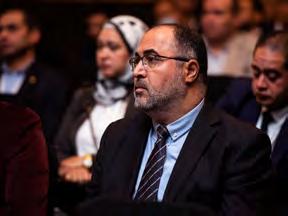
The third session was concluded with a presentation titled “Asset Integrity Management (AIM): Challenges and Strategies for Successful Implementation” by Mohamed ElHabbal, AIM Program Manager/ Assistant General Manager Offshore Division at Enppi. The main goal of ElHabbal’s talk was to explore the challenges and best strategies for the purpose of achieving efficient AIM systems.
OUTSTANDING SOLUTIONS FOR IMPROVING PRODUCTION
The fourth technical Session of the 8th Convention, provided very interesting and informative four presentations on how to improve oil and gas production.

Mohamed El-Ghamry, WEPCO's Geophysics Section Head, added a scientifically enlightening perspective in his presentation titled "Turning Plug and Abandonment Dry Wells From Disasters to New Discoveries: Case Study Bed-1 Brownfield Western Desert, Egypt". His study aims to maximize production form field BED-1 through using dry, abandonment and long shutin wells. El-Ghamry concluded that this strategy pumped reserves to BED – 1 well reached 12 million barrels (mmbl).
Another presentation titled "Unlock Unseen Development Potential in Brown Field: Case Study Shahd SE Field", was provided by Mohammed Ismael, ENAP Sipetrol's Operations Manager. He discussed how the data acquisition, repeated analysis, and evaluation workflows could uncover unseen potentials reach to around 9 million stock tank barrels of original hydrocarbon in place. He elaborated that the key to such successful workflow is the integration between different data analysis and how to eliminate the uncertainties by more data acquisition and uncertainties assessment.
Additionally, Maria Vazquez from SLB, Mohamed Soliman and Mohamed Tarek from SUCO offered an informative presentation titled "Improving Existing Perforations Efficiency with Innovative Dynamic Underbalance Implosion Technique, Enhanced Productivity in Ras Budran Field". He evaluated the production of Ras Badran after applying underbalance implosion technique. He concluded this technique succeeded to improve the production rates reaching to 1.5 mmbl and double the remaining reserves.
Mostafa Kortam from Petrobel introduced a presentation titled "Neutralwettability Proppant Improves Post Treatment Cleanup and Enhances Productivity". In his presentation, he tried to solve sand production problem recommending to use Garvel Pack and Frac Pack techniques. His study proved that no sand formation produced by using Gravel Pack technique. It also led to 100% recovery of pumped brine and increased the productivity index (PI) by around 15% compared to offset wells.
DECEMBER 2022 - ISSUE 192 | 15 www.egyptoil-gas.com
CAPACITY BUILDING
BUILDING PEOPLE FOR A BETTER SECTOR
The third day of the 8th Egypt Oil & Gas (EOG) Convention witnessed a Capacity Building feature, which was opened by Wolfpack CEO Kelly Bone giving a live coaching session titled “The Blue Ocean Mindset”. It encouraged people to live in the wide ocean of opportunities all the time and to seek the discomfort because in the discomfort is where people grow and expand the most and teaching the audience the difference between buffalos and cows in response to the storm, inspiring people to not turn heel and escape from the difficulties but rather to run right toward them and trying to solve them.
Then an inspiring panel discussion entitled “Building the Future Energy industry’s Blueprint for Success” moderated by Bone. The panelists were Alaa El Maraghy, Assistant Chairman for ICT-Rashid Petroleum Company, Bassem Embaby, Senior Vice President, Senior Director Egypt- Wintershall Dea, Nihal Abdelkarim, Development Engineering Company Manager IEOG, Samir AbdelMoaty, Quantity Manager, Egypt United Oil and Gas, Wang Hao, CTO of Energy, North Africa Region-HUAWEI.
For his part, Alaa El Maraghy, Assistant Chairman for ICT-Rashid Petroleum Company, commented: "The most important thing I want to tell you about is that there is a vision for the Ministry of the Petroleum which is concerned about people. We have a lot of capacity-building programs not only the Middle Management Program. Tomorrow we will start another program for executive leadership and also a program for process safety and other programs for energy efficiency, so there is a vision to modernize the oil and gas sector that we are working on."
When it came to AbdelMoaty’s opinion, achieving progress is about making impressive accomplishments in human resources. "Every industry needs to work on their people first because that prepares them for the future."
DECARBONIZATION FEATURE
Moving on from just the philosophy of just building people, Embaby’s belief is that driving human beings to accomplish more always depends on the habit of having high expectations. “It is very important to bring up all expectations and people working on the process into the same level, [then] start to build up the capacity on this [level].”
However, for Hao, progress has to also go beyond human capabilities through the use of technology "There's something I want to say to the companies that want to do the digital transformation: embrace the technology and charge (into) the storm. Don't try to outrun the storm because you're just prolonging the pain."
DECARBONIZATION DOMINATES THE SCENE ON DAY 3 OF THE 8TH EOG CONVENTION
During the third day of the 8th Egypt Oil & Gas Convention, the Decarbonization Feature program witnessed a variety of presentations, success stories and case studies all tackling the challenge of accomplishing decarbonization objectives in Egypt’s oil and gas sector.

It started with a keynote presentation titled 'Importance of Decarbonization and How to Reduce Your Carbon Footprint' by Concetto Fischetti, Energy Transition Director at IOGP, who highlighted the main requirements for achieving decarbonization, especially in Egypt.
During his presentation, he outlined the importance of energy security to Egypt. Fischetti noted that Egypt has a good energy industry that could attract international investors. “Energy transition requires a strong collaboration among the investing sector, public sector, and the users,” he said.
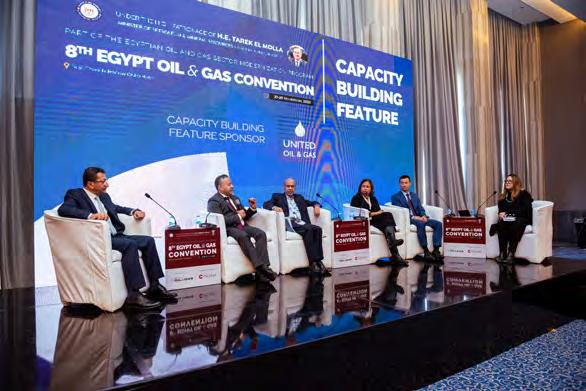
Fischetti stressed that Egypt requires three pillars for building an energy transition pathway. The first pillar involves natural gas, which is an enabler for increasing the electrification of the country. The second pillar is to step up in the low carbon technologies like carbon capture, transportation, and storage as well as hydrogen technologies. The third pillar is the strong cooperation between the private sector, the public sector, and consumers. Fischetti ended his presentation by discussing his company’s actions and efforts to implement decarbonization targets and increase related awareness.
Moreover, the Decarbonization Feature witnessed a panel discussion on how to apply decarbonization techniques in Egypt. For Apache, data and accuracy are the vital components that are critical for ensuring the survival of any decarbonization project. “[Emissions reduction] starts with data in the field, understanding your
operations, what equipment you've got in the field, the operating conditions, and what are the contributors to your emissions. That's where it starts," Greg McDaniel, General Manager & Managing Director of Khalda Petroleum Company and Vice President of Production Operations at Apache, noted.
Highlighting the importance of technology in developing their decarbonization pathway, Alessandro Caschili explained that “Technological innovation is the trigger…. Technology should be the base of decarbonization.”
Fischetti agreed, saying that "Technology is key to increase the level of accuracy on the energy transition data but the first step is to make sure that each company is clearly reporting its emissions."
Additionally, several companies in the oil and gas sector have already started working on reducing their carbon emissions. Tarek Hamouda, Energy Transition & Sustainability Program Manager-Enppi said "We are expecting to reduce emissions by about 120,000 tons of carbon per year. This is (what we have been) talking
about in COP27. We are moving from ideas, policies and strategies to on-ground progress."
At the end of the Decarbonization Feature, two companies won awards for their decarbonization achievements. Apache Corporation got first place and the award was received by Greg McDaniel- General Manager & Managing Director of Khalda Petroleum Company and Vice President of Production Operations at Apache. While, Agiba Petroleum Company was given second place and the award was received by Mohamed Yahia, Meleiha Construction Assistant General Manager at the company.
| EGYPT OIL & GAS NEWSPAPER 16 EOGC'22
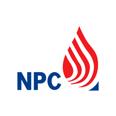


SUPPORTER AND SPONSORS THANKS PLATINUM SPONSORS SUPPORTED BY TECHNICAL WORKSHOP SPONSOR STRATEGIC PANELS SPONSOR DELEGATE BAG & NAME TAG SPONSOR OPERATIONAL EXCELLENCE AWARDS SPONSOR ROUNDTABLE SPONSOR LUNCH SPONSOR ESG PARTNER CAPACITY BUILDING FEATURE SPONSOR SILVER SPONSOR GOLD SPONSORS ANNIVERSARY CELEBRATION SPONSOR HEALTH & SAFETY SPONSOR DECEMBER 2022 - ISSUE 192 | 17 www.egyptoil-gas.com
BY JOLLY MONSEF, MARIAM AHMED & YOUSTINA MOUNIR

Gas flaring is generated by the combustion of gas coming from many industries; mostly from refineries and petrochemicals complexes. Globally, in 2021 about 143 billion cubic meters (bcm) of natural gas were flared. This resulted in the direct release of 270 million tons (mmt) of CO2 and nearly 8 mmt of methane into the atmosphere. In the mentioned period, Egypt represented about 1.5% of global gas flaring, according to the World Bank. In this regard, Egypt spares no efforts in implementing gas flaring recovery projects.
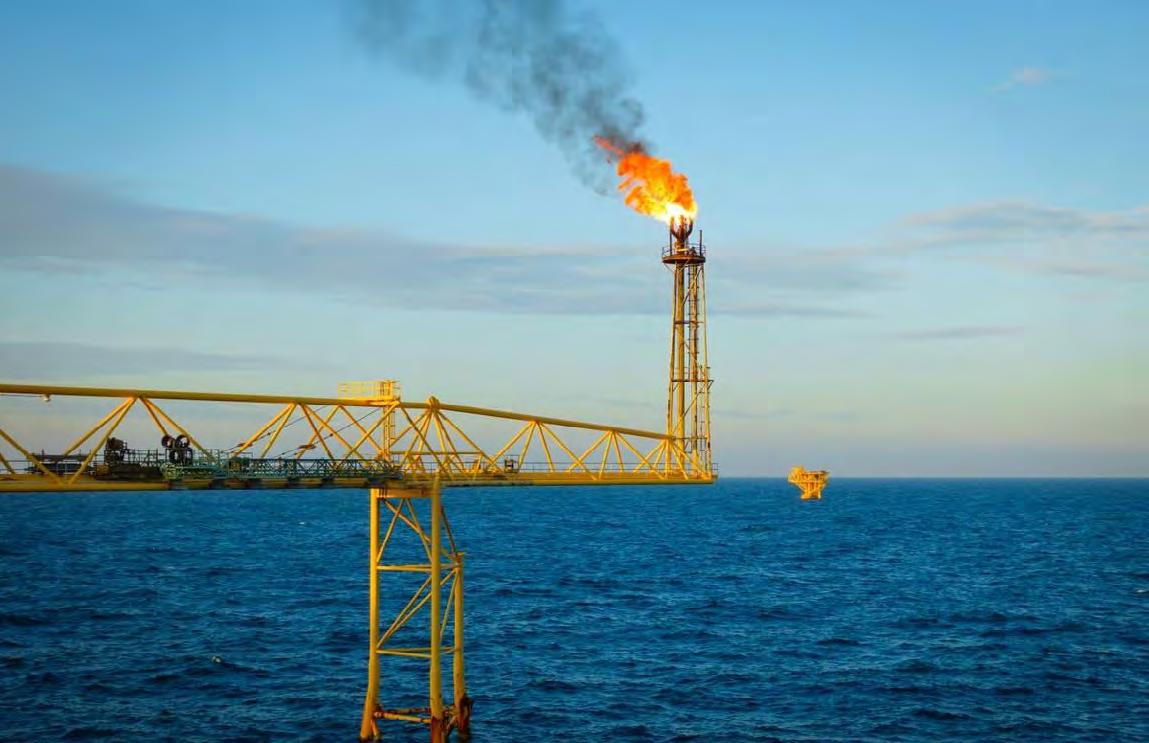
Challenges
Gas Flaring in Egypt: Opportunities and
Gas Flaring in 2021 11.78% TOP 10 LARGEST FLARING COUNTRIES GLOBALLY GAS FLARING IN EGYPT Russia Iraq Iran US Venezuela Algeria Nigeria Mexico Libya China 25,409 17,800 17,376 8,764 8,189 8,156 6,627 6,509 5,999 2,488 6.9 11.9 15.4 2.2 38.2 19.8 11.8 10.4 13.2 1.7 Flaring Volume (million m3/y) Volume (million m3/y) Intensity (m3//bbl) Flaring Intensity (m3/bbl) The 10 largest countries accounted for 75% of all gas flared volume 2,360 2020 2,082 2021 7.27% 11 2020 10.2 2021 | EGYPT OIL & GAS NEWSPAPER 18 RESEARCH & ANALYSIS
Egypt’s Efforts Towards Reducing Gas Flaring in 2022
Egypt contributes to the global efforts to keep the environment safe and reduce gas flaring emissions. In light of the oil and gas sector’s Modernization program, Egypt made 13 flare gas recovery projects in 10 companies with a total recovery of 40 mcf/d of gas. Moreover, Egypt has entered into major partnerships and joined the “Zero Routine Flaring by 2030” Initiative in 2017 which was launched by the World Bank in 2015 to find solutions to end routine flaring


Projects 2. International Partnerships GENERATING ELECTRIC POWER FROM FLARE GAS PROJECT* FLARE GAS REDUCTION PROJECT FLARE GAS MONITORING PROJECT ZERO FLARE GAS RECOVERY PROJECT Announced Date Executors PetroSafe & Baker Hughes May 2022 March 2022 Khalda Petroleum Co. (Joint Venture of Apache) 10 MW The Kalabsha fields in the Western Desert Providing nearly 80,000 liters/d of Diesel, which will contribute to reducing carbon emissions Aim Using Flare IQ Technology to reduce harmful gas emissions to the least possible degree Announced Date Location Target Company Capacity *Largest project in terms of size in Egypt and North Africa Announced Date June 2022 Executor PetroSafe Aim Monitoring & identifying the amount of emissions that could be reduced using the monitoring system developed by Baker Hughes Announced Date September 2022 Company Cairo Oil Refining (CORC) Investment Cost EGP 150 million Phases 2 Unit Capacity 4 t/h of Gases BAKER HUGHES SIGNED MOU WITH EGPC HIIROC SIGNED MOU WITH EGAS FEASIBILITY STUDY AGREEMENT Signing Date Aim February 2022 Establishing a flare recovery initiative to reduce emissions within oil & gas operation in Egypt Reducing Gas Flaring Emissions Zero-emission Hydrogen project using a British technology for electrolysis of thermal plasma Egyptian LNG & Bechtel-led Coalition for decarbonization (ENPI, Petrojet, Baker Hughes, GE Digital, HSBC and NBE) Evaluating the implementation of a zero-flaring system at the Egyptian LNG export terminal (ELNG) in Idku Signing Date Aim November 2022 Signing Date Parties Aim November 2022 DECEMBER 2022 - ISSUE 192 | 19 www.egyptoil-gas.com
at existing oil production sites by 2030. Since that, Egypt has signed several memoranda of understanding (MoUs) to strength cooperation in gas flaring reduction projects. 1. Major
Challenges
Countries face interlinked challenges in reducing and eliminating gas flaring. These challenges differ from one country to another and cover a wide range of factors, including technical, regulatory, economic, and political factors.
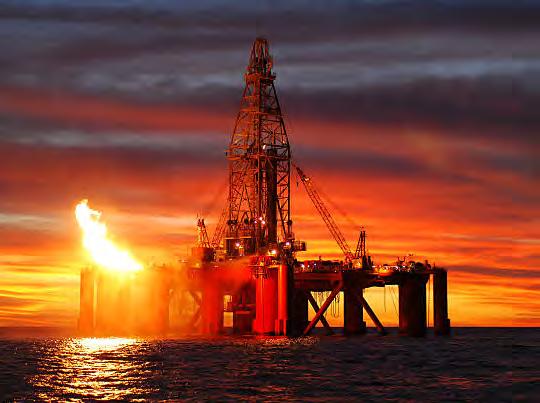
REDUCING GAS FLARE CHALLENGES
Absence of coordination or integration between energy and environment policies addressed gas flaring
Conflict and political instability which add to the financial and environmental costs
Financing
Gas flaring is not only a climate change threat but also a monumental waste of natural resources that should either be used for productive purposes or conserved. In this regard, Egypt pledges to reduce emissions from gas flaring in the oil and gas sector in its Nationally Determined Contributions (NDC), as well as its Long Term Low Emission Development and Climate Change Strategies. Egypt still has a long journey toward reducing emissions, yet it leans over backwards to transform its environment into a more sustainable and green one.
Lack of compression and transportation infrastructure
obstacles for some countries
High cost of gas capturing in small oil production sites within large areas
No clear regulations between the rights of the country and the company
| EGYPT OIL & GAS NEWSPAPER 20 RESEARCH & ANALYSIS
NESR and Scimitar have successfully pumped the first propped hydraulic fracturing job in Issaran field
NESR and Scimitar have successfully pumped the first propped hydraulic fracturing job in Issaran field which is an ultra-shallow carbonate reservoir with heavy oil. Steam was injected in well post treatment and the well has shown great potential in terms of production thus unlocking the reservoir’s true potential.
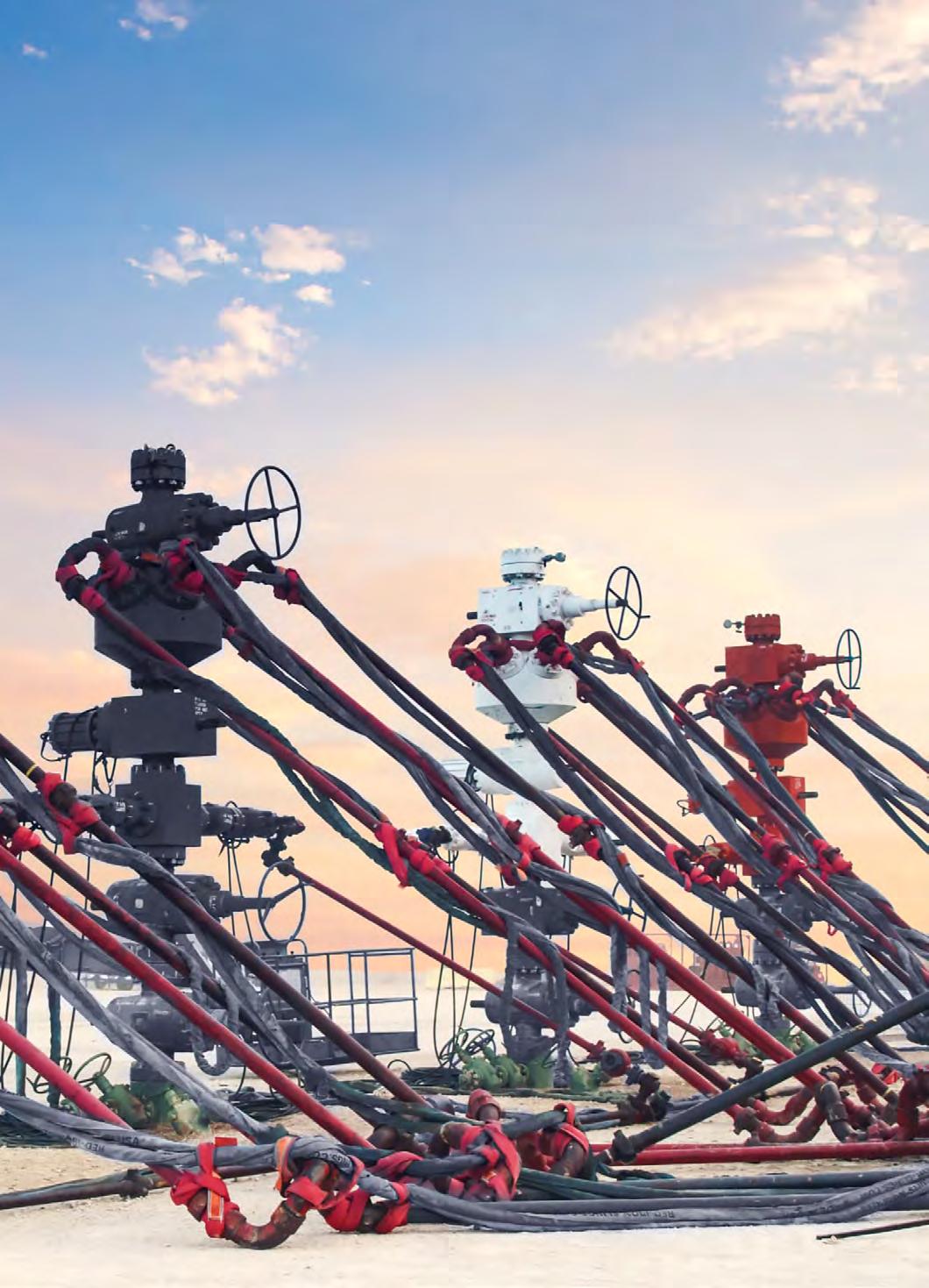
www.nesr.com
DECEMBER 2022 - ISSUE 192 | 21 www.egyptoil-gas.com
CARBON NEUTRALITY: THE PENULTIMATE SOLUTION
 BY RANA AL KADY
BY RANA AL KADY
Carbon neutrality is not a hindrance, it’s a necessity. Oil and gas companies passed just simply installing solar panels on roofs or carpooling to work –we are beyond that point now. It is essential to combine a series of solutions to achieve carbon neutrality by canceling out carbon emissions released by such a carbon-intensive industry. This is one of the main themes tackled and discussed during the recent United Nations (UN) Climate Summit that took place in Sharm El Sheikh earlier last month (COP27).
GENERAL OVERVIEW
Nations acknowledged at COP26 in Glasgow that carbon output levels were expected to be 14% higher in 2030 than in 2010. To keep global warming to 1.5 degrees Celsius, emissions must be cut by 45%. They convened to create a scope of work that aims mainly to direly ramp up mitigation aspirations and execution in this crucial couple of years to address this issue. Countries openly discussed the ways in which this scope of work could operate in Sharm elSheikh. The developed and susceptible nations wanted the discussions to be lengthy, robust and focused. The developing markets desired that they be short and broad.
In today's world, economies rely on the concrete, iron, steel, chemical industries, and petrochemical products businesses. Notwithstanding the emission of pollutants, they must play a critical role in the lowcarbon post-pandemic turnaround. Such energy-intensive businesses can shift to a carbon-neutral market whilst also preserving or perhaps even enhancing their international competitiveness. Implementing circular economy strategies to assist in reducing the need for new materials will be critical in this regard. Alternatives should be executed as soon as possible. For this reason, COP27 brought about the East Mediterranean Gas Forum regional decarbonization Initiative in hopes of expediting this process.
ACHIEVING CARBON NEUTRALITY
As per the International Energy Agency (IEA), if indeed the globe is to achieve carbon neutrality by 2050, new crude oil, natural gas, and coal harvesting and growth must cease by 2021. In this respect, investment in research and adoption of renewable energy from carbon-free sources such as renewable energy technologies is critical to closing the void between net-zero CO2 emissions propaganda and actuality.
Some experts claim that the globe isn't on route to reaching carbon neutrality and environmental sustainability by 2050 because the transformation from traditional to renewable energy is taking too long. As a result, greater work is required to morph the energy sector into a climate-neutral powerhouse. This can be attained by collaborating with
numerous multidisciplinary research teams and applying an interdisciplinary approach created as a result of the latest advances in science and technology in environmental engineering, biotech, material science, and other areas. Furthermore, with the development of renewable energy, food system management must be optimized to ramp up production effectiveness and lower CO2 pollution.
This could be accomplished by developing new technologies and continuing to develop carbon-neutral agricultural systems. Considering that the planet is not likely to significantly decrease CO2 emissions from fossil fuels in the immediate future, using the potential of natural resources and methods to eliminate CO2 from the atmosphere brings the industry - and eventually the world - one small but critical step closer to being able to achieve carbon neutrality. As mentioned by an oil and gas industry expert and COP27 participant, “[Egypt] has a lot of plans for the future goals to be achieved to become carbon natural, but the real problem we have to focus on is making sure [oil and gas companies] are all working towards the same goal. Right now, some companies have sustainable measures but others are producing large amounts of emissions. So, there has to be a common goal and a mutual way of operation. This is something that COP27 allows us to discuss with the right persons.”
According to the IEA report, policymakers must dare to endorse any new oil and gas fields, in addition to any novel unhindered coal-fired power plants in the near future. It states that new purchases of fossil fuel boilers must be phased out by the close of 2025. These are only just some of the more than 400 benchmarks outlined in the International Energy Agency's Net Zero by 2050 study, which lays out a roadmap for the world to adhere to in order to achieve net zero carbon emissions by 2050.
In the oil and gas business, pragmatically, getting the globe to net zero by 2050 would necessitate a number of achievements in the governmental, corporate, technological, and social spheres. It will be a massive task to move those targets from the realm of imagination to real life, imploring nations to expedite their green power action plan.
| EGYPT OIL & GAS NEWSPAPER 22 INDUSTRY INSIGHTS
Our customers are our greatest asset; we aim to provide them with a one-stop service in the most economical way through understanding their needs, solving their problems, and being a supportive consultant.

VROON OFFSHORE SERVICES excels in the provision of diverse services and solutions for key o shore-support needs, including platform supply, emergency response and rescue, anchor handling tug supply, walk to work, crew transfer and subsea support. In addition, Vroon O shore Services o ers a wide range of complementary o shore services.
With a versatile eet and highly quali ed and experienced colleagues, we are committed to providing seagoing transportation services and engineering & support solutions that are reliable, sustainable, cost e ective and enable our customers to be successful.


Leaders in Safety Head O ce: Marhaba Tower, Fouad St., O Horeiya Road, Alexandria
Egypt Tel.:
(10 Lines) Fax: +2033913829 Email:
21131,
+2033913820
O shore@pan-marine.net
1-
2-
3-
4-
PAN MARINE GROUP is a ONE-STOP service provider to our clients in Egypt through the following four companies:
Pan Marine Shipping Services
Pan Marine Logistics Services
Pan Marine Petroleum Services FZ
Medkon Lines Egypt S.A.E
PAN MARINE GROUP VROON OFFSHORE SERVICES ABERDEEN | DENHELDER GENOA | | SINGAPORE ....CONNECTING MARKETS “TOGETHER, YOUR PARTNERS IN EGYPT” YOUR ONE-STOP SERVICE PROVIDER P A NMARINEGRO U P ALEXANDRIA | CAIRO | DAMIETTA PORT SAID | RAS GHAREB | SAFAGA ABU QIR | SUEZ | SOKHNA ISO 9001:2015 ISO 14001:2015 ISO 45001:2018 ISO 29001:2020 www.egyptoil-gas.com DECEMBER 2022 - ISSUE 192 | 23
www.pan-marine.net www.vroono shore.com
OIL, GAS SECTOR LEADS EGYPT’S DECARBONIZATION JOURNEY
BY SARAH SAMIR
Egypt has been contributing positively to climate action movements and initiatives to face the challenges of climate change, while the Egyptian oil and gas sector has been at the forefront of Egypt’s decarbonization efforts. At last, the United Nations (UN) Conference of Parties (COP 27), which was held in Sharm El Sheikh in November, has given the oil and gas firms the opportunity to show their efforts and the role they can play in facing climate change. The Participation of the oil and gas sector in the summit's activities, and especially in the Decarbonization Day, held on November 11, was a remarkable addition to the COP activities.
Decarbonization Day
Decarbonization Day has given oil and gas companies a voice in the climate action road mapping. Decarbonization Day was an ideal platform for global organizations, industry stakeholders, and energy companies to discuss and present their commitments, initiatives, and actions to improve the global climate situation, Minister of Petroleum and Mineral Resources Tarek El Molla stated as he concluded the Decarbonization Day activities in which oil and gas sector engaged in several panel discussions, meetings and agreements signings.
The activities of the day gave hydrocarbon leaders the opportunity to discuss energy transition feasibility, highlighting the importance of fossil fuels in the transition.
The oil and gas industry must be part of the energy supply guarantee solutions, with full commitment to applying carbon emissions reduction and the use of clean production technology, and support must be provided to achieve this, Siemens CEO Christian Bruch stated during the first-panel discussion in the Decarbonization Day.
The Decarbonization Day's discussions of several topics, including the decarbonization challenges, supporting low-carbon development pathways for Africa and the developing world, ways of advancing the global methane pledge, efficiency achievements, EMGF decarbonization initiative, accelerating decarbonization, industries' decarbonization journey, and decarbonization of the ministry of petroleum.
Green Cooperation
The Decarbonization Day did not only bring industry leaders together for discussions but these discussions were translated into cooperation. Egypt has taken the opportunity of COP 27 to sign a number of memoranda of understanding (MoUs) and agreements for green cooperation.
The MoUs came as an extension of the efforts launched by the Ministry to enhance the capabilities of the Egyptian oil and gas industry in the field of carbon reduction and environmental sustainability of projects, and to benefit from the best experiences and practices provided by international companies in this field, El Molla commented on the MoUs and agreements.
The Egyptian LNG Company signed a feasibility study agreement with the Bechtel-led Coalition, which includes Enppi, Petrojet, Baker Hughes, GE Digital, HSBC, and NBE. The study will evaluate the implementation of a zero-flaring system at the Egyptian LNG export terminal (ELNG) in Idku.
Moreover, the Egyptian Natural Gas Holding Company (EGAS) signed 6 MoUs and agreements for decarbonization. One MoU was signed with Shell Egypt with the aim of cooperating in establishing a framework for managing greenhouse gas emissions and reducing greenhouse gas emissions from the operations of all EGAS partners. Another MoU was sealed with SeaSplit Technologies, and General Electric (GE) to remove industrial carbon from the Gulf of Suez.
EGAS also signed one MoU with Egyptian General Petroleum Corporation (EGPC), and the French TotalEnergies Marketing Company in Egypt to cooperate with each other in evaluating the technical and economic feasibility of carbon removal solutions in the petroleum sector. Another MoU was signed with Microsoft Egypt to cooperate in developing the sustainability roadmap for EGAS.
Furthermore, EGAS signed an initial agreement with the Egyptian Petrochemical Holding Company (ECHEM), and the Japanese Toyota Tsusho Company to cooperate in developing a feasibility study for a project to produce blue ammonia as clean energy in Egypt.
Putting these agreements and MoUs into action, the Egyptian oil and gas sector is set to lead a clean energy transition that has fossil fuels in its core. This comes as the world agrees that a safe and feasible energy transition still needs hydrocarbon in its mix, which is reflected in holding the Decarbonization Day as a part of COP 27 in Egypt.

| EGYPT OIL & GAS NEWSPAPER 24 OVERVIEW
PETROLEUM POWERS UP THE GREEN ECONOMY
BY NADER RAMADAN
They say two opposites attract, but when talking about green economy and petroleum it goes beyond just that. These are two economic forces that complement each other. When studying the growth of the green economy, one would naturally assume petroleum and the green economy would have an inverse relationship, but many petroleum companies are working to debunk this common misconception. As discussions about climate change continue, many of the oil and gas industry’s biggest names are hard at work in adopting economic strategies to expand and diversify the green economy for the purpose of sustaining economic growth while addressing pressing concerns about climate change, global warming, and the surge of harmful greenhouse gas (GHG) emissions.
Expanding green investments is one of many economic approaches that have played a big part in boosting the green economy as there’s no denying that when the cash gets pumped into the system, the economic wheel starts turning. Shell for example has had a number of notable contributions to developing and growing the green economy including financing its Renewables and New Energy Solutions division with up to $2-3 billion. As a company, its main focus given current climate concerns is to decarbonize and focus on electricity. All of its reforms paid off when Shell started offering its British residential customers electricity that is 100% renewable. This entails that when every unit of electricity is used, an additional unit is put back into the grid by renewable generators.
One of Shell’s biggest executives even noted that efforts in promoting the green economy have shown positive results, with the expanding renewable electricity sector becoming a trend in business communities across the UK. “A recent survey of senior business decision makers across the U.K. found that almost two thirds either already purchase renewable electricity or are planning to do so as environmental factors become more important to businesses of all sizes,” said Colin Crooks, who was CEO of Shell Energy Retail Limited at the time. “We can help them on their decarbonization journey, by offering simple and reliable solutions for managing their energy costs and planning their sustainability roadmap. Together, we can play a part in the U.K.’s national drive to net zero carbon emissions.”
Diversity is an essential aspect of enabling the growth of any healthy green economic sector, an endeavor which TotalEnergies has sought to contribute to by working to develop different green sectors and others types of renewable fuels including, most notably, biomass. This is in addition to its active involvement in promoting new promising markets in wind energy, solar energy, and hydropower. Consistent with strategies set by many oil and gas companies, TotalEnergies has also established a new subsidiary in 2021 called Total Quadran which operates up to 340 renewable energy plans (including 224 solar plants) in France. This represents a huge leap in promoting the green economy as an essential provider of essential utilities, including up to 1,765 GWh of renewable electricity annually.
Apart from diversity, it could easily be said that some companies are even becoming part of the green economy itself, such as Equinor which aims to diversify its scope of work. This is in addition to joining the Climate Action 100+ initiative which involves a large group of ambitious investors as well as $33 trillion worth
of assets. “Equinor is developing as a broad energy company, with oil and gas, renewable energy and CCS as integrated parts of our business,” the company said in a statement. “In our Climate Roadmap, we communicate our commitment to reduce own emissions and help drive decarbonization by scaling up investments in new energy solutions and low carbon R&D. We recognize the value of transparent reporting of climate-related risks and annually stress test our portfolio against recognized low-carbon energy scenarios.”
Studies have also shown the growth of the green economy has been accompanied by increasing demands for digitalization, not only for regulating and minimizing emissions but to optimize operational and energy efficiency. According to the study titled “Digital Economy, Technological Innovation and Green HighQuality Development of Industry: A Study Case of China” by Li Liu, Tao Ding and Hao Wang, digitalization can be used “to raise the level of efficiency of carbon accounting of investment and financing projects and enterprises by financial institutions through digital technology, establishing the carbon footprint disclosure system of financial institutions, to provide preferential investment and financing conditions for green and low-carbon enterprises and projects and force enterprises to green transformation will be useful in a forward-looking envisioning of green development.” Baker Hughes and other big multinationals have had big accomplishments in promoting digitalization, which can enhance the efficiency of any green economic sector.
The expansion of the green economy is not only vital for societies to enjoy economic prosperity and open the doors for limitless development but it has also become essential for the global community’s environmental security. When drawing up plans for a better tomorrow, it is important to understand that the possibilities in the green economy are endless because it does not involve just renewable energy, but several other sectors including green buildings, sustainable transport, water management, waste management, and land management. The sky is the limit as it includes any sector of the formal economy that works to promote or preserve the environment, ecosystems, and biodiversity. Now, the green economy is no longer just a handful of small businesses that sell non-plastic bags or dresses made out of environmentally friendly materials. It is an economic force that has to be reckoned with, which is an accomplishment that would not have been possible without the efforts of the oil and gas industry.

DECEMBER 2022 - ISSUE 192 | 25 www.egyptoil-gas.com ENERGY ECONOMICS
DIRECT AIR CAPTURE (DAC): NEW TRACK TOWARDS DECARBONIZED WORLD
BY FATMA AHMED
As the climate change crisis increases, technology providers seek to develop new solutions for reducing carbon emissions. Carbon Capture systems are the best recent solutions used in this regard. Direct Air Capture (DAC) is one of the technologies used for this purpose. It is mainly based on extracting carbon dioxide (CO2) directly from the atmosphere.

DAC: Capturing Carbon from Air
Direct Carbon Capture is a technology that could separate CO2 from the air directly. This is done by using large fans which draw the air into the DAC unit, then the air passes through a series of chemical reactions which adsorb the carbon dioxide particles leaving the clean air to go back into the environment. This process is similar to how human lungs extract oxygen. It is also similar to what plants and trees do every day, except it is much faster.
An article released by “Carbon Engineering”, which is one of the DAC developers, explained in more detail how this process is done. It said that this technology has an air contractor which is a giant fan to pull the air, then the air passes a liquid or solid chemical material. This non-toxic solution chemically binds with the CO2 molecules, removing them from the air. Then, this material is exposed to chemical processes and heat making CO2 more concentrated, purified, and compressed. According to an article published by “The Conversation”, this concentrated CO2 can be either stored in old oil and gas reservoirs or used to produce useful chemicals such as synthetic fuels.
As mentioned above there are two technological approaches to capturing CO2 through DAC; solid DAC and liquid DAC. The International Energy Agency (IEA) stated that solid DAC is based on solid adsorbents operating at ambient to low pressure for example under a vacuum and medium temperature (80-120°C). while liquid DAC (L-DAC) relies on an aqueous basic solution such as potassium hydroxide. This solution releases the captured CO2 through a series of units operating at high temperatures (between 300°C and 900°C).
DAC: Good Choice
This technology has many benefits making it one of the best choices for decarbonization purposes. It is location-independent which means that DAC plants can be established anywhere as CO2 exists in the air with the same density everywhere. It just needs to be close to a source of renewable energy and a place in which CO2 can be stored. As mentioned above, DAC works in a way similar to trees but on a larger scale, faster and with less distance needed for hosting trees. Although DAC seems to be more expensive than other solutions in its costs due to its need for much energy, it is affordable on a large scale.
Investments In Reality
Despite the technology is still in its early stages, this technology has been growing during the past few years. According to IEA, 18 DAC plants are now
operating around the world; especially in Europe, the US, and Canada. All these plants are at a small scale which capture almost 0.01 million tons of CO2 per year. Now, the US is developing the first large-scale DAC plant which will capture up to 1 million tons per year. This project is expected to start operation by the mid-2020s.
Also, some governments are now developing a number of policies and programs supporting DAC development and deployment. Moreover, they have committed almost $4 billion to fund DAC projects. For example, the US legislated 45Q tax credit (providing $35 per ton of CO2 used in enhanced oil recovery and $50 per ton of CO2 stored) in addition to the California Low Carbon Fuel Standard credit (providing the DAC project meets the requirements of the Carbon Capture and Sequestration Protocol), IEA stated.
Additionally, in the IEA Net Zero Emissions by 2050 Scenario (Net Zero Scenario), DAC deployment rapidly scales up to reach around 85 million tons of CO2 in 2030 and 980 million tons in 2050. Moreover, private investors are supporting such technology, as well. Breakthrough Energy Catalyst, established by Bill Gates and a coalition of private investors, has dedicated $1.5 billion to invest in four technologies including DAC. During 2021, many investments in DAC were announced involving the Storegga Dreamcatcher Project and the HIF Haru Oni eFuels Pilot Plant, IEA said.
DAC in the Coming Years
There are many plans for DAC investments during the upcoming period. Norsk e-Fuel AS consortium has set a target to produce up to 3 million liters of Synthetic fuels by 2024 including (but not using exclusively) CO2 captured from DAC in Norway. Also, 1PointFive and Carbon Engineering together announced in June 2022, plans to deploy 70 large-scale DAC facilities by 2035 with a capture capacity of up to 1 million tons per year for each.
Meanwhile, Climeworks announced the construction of their largest plant to date, Mammoth with a capture capacity of up to 36,000 tons CO2/year, which is expected to become operational by 2024. According to IEA, plans for 11 DAC facilities are now in advanced development stages. Upon operation, DAC deployment would reach around 5.5 million tons of CO2 by 2030 which is more than 700 times today’s capture rate, but less than 10% of the level of deployment needed to get on track with the Net Zero Scenario, IEA stated.
| EGYPT OIL & GAS NEWSPAPER 26 TECHNOLOGY
EFFECTIVE LEGISLATION TO ESCAPE THE GLOBAL ENERGY CRISIS

NEW INNOVATIVE AND FLEXIBLE ECONOMIC LEGISLATION MAY BE THE WAY OUT OF THE CURRENT ECONOMIC IMPASSE
By Eng. Mohsen Ahmed Farhan Ali - Oil & Gas Well Drilling Specialist - Kuwait Oil Company (KOC) Consultant- Oil & Gas Industry Trainer & Coach
The current political and economic situations worldwide may be the most difficult through the last two decades. Hence, there is a dire need for creating a new suitable way forward for going out of that impasse. As a roadmap that we can use to navigate ourselves out of this crisis, then we can work for going far from such as economic falls, new flexible laws and immediate decisions supported will have a great effect on controlling inflation rate and the depreciation of the currency’s value. With a huge increase in all goods’ prices, there is a for corrective actions and procedures for getting new resources for national income and attracting new investments.
All new legislation should be created based on a win-win concept for providing benefits for all partners or participants in any economic activity inside the country. Therefore, the rescue plan has to be set up on cooperation and integration principles between all concerned establishments inside the management system of the state. Any economic decision or regulation has to be subjected to detailed social study before going ahead for applying same to avoid people’s resistance and their negative attitudes towards that new legislation that may be considered as a good solution for their hard problems.
Some issues can lead to new legislation application failure or loss of economic benefits coming from that new regulations/laws like a trial to achieve some benefits for a special group of business pioneers or governmental responsible, ignorance of the social effect of that law or decision, delay of rescue legislation creation and application during critical situations, incomplete legal frame of that legislations may lead to negative results and increase bad effects, and developing of illogic conditions or impossible requirement from the other partners for applying that regulations.
All of these new legislations that have been created for critical economic conditions, have to be set up based on a fixed time frame and follow to gradual implementation scheme to achieve their objectives with minimal negative impacts. Once an economic system exceeds the bottleneck point in any crisis, new legislation and decisions should be suitable for the next stage of recovery.
The energy sector is not out of that correction actions and new legislations; I think is in heart of any development or rescue plan for any country’s economy. I see that managerial systems enhancement and human resources development through a group of new smart legislations can be a very good direction for the Egyptian energy sector in the upcoming next years.
I think the most of solutions for the current economic crisis should come from inside the country through building trust between the government, people, and national investors. This is considered the three-sided triangle of any progress in the country and each component is strongly connected to the welfare and prosperity of the other. Confidence between the three partners should be created through well-respected laws and regulations that will achieve the benefit of all.
In the end, I need to support & clarify my ideas related to developing new flexible and innovative legislation for managing the current severe economic crisis by examining the following two examples of new innovative legislation or laws that can affect the Egyptian economy greatly in the short to medium term. The first example is the new law for regulating agriculture inside Egypt based on a governmental plan for producing agricultural products that are suitable and valid for
export to neighboring countries in the Arab Gulf and wider Middle East. Other agricultural products can be used in food industries through a big group of new factories that can be supported by the government side through facilitating all production requirements and developing governmental authority for exporting, on behalf of the producers, to the Arab and African countries.
The second example is a new law for the establishment of a new Silicon Valley for programmers and software developers, which will support them in developing new programs, computer software, and mobile phone applications by suitable regulations for tax-free, assistance in marketing their products worldwide through propaganda and advertising organizations, and providing suitable training for innovative persons in reputable companies and organizations for gaining new high skills to cope with the latest technologies and programs.
The third example of new legislation/regulation that will benefit the national economy and national income greatly is setting up a new smart governmental organization for human resources investment and development, as a national project, then exporting them to the countries in need of their efforts and skills under complete care and support of the Egyptian Government.
The proper way for achieving organizational targets efficiently may need to provide good coordination and integration with the other partners e.g. foreign affairs ministry, labor ministry, and higher education ministry, and national training academy for preparing the qualified & well-experienced candidates to win good positions in different fields outside Egypt, then they will be a good source for national income and saving foreign currency for their country and on the other side this project will be a good procedure for reducing the unemployment rate in the country.
I think the good diplomatic relationships between Egypt and most countries, especially Arab countries will support this national project.
DECEMBER 2022 - ISSUE 192 | 27 www.egyptoil-gas.com LEGAL
COP27: EPIC ACHIEVEMENTS AGAINST ALL ODDS
BY IHAB SHAARAWY
Taking place against the backdrop of tough world circumstances, including the conflict in Europe, widening rifts between world powers, and deteriorating economic and environmental situation, the mission of the COP27 seemed to be very challenging. However, the 27th UN Climate Change Conference (COP27), held in the Egyptian Red Sea city of Sharm El-Sheikh, was able to reach remarkable breakthroughs toward climate change mitigation.
Against all the odds, COP27 concluded with a package of decisions that reaffirmed the world countries’ commitment to limit global temperature rise to 1.5 degrees Celsius above pre-industrial levels. The package also strengthened action to cut greenhouse gas emissions and adapt to the impacts of climate change and most importantly boosted the support of finance, technology, and capacity building needed by developing countries.
The COP27, known as the Africa COP, provided an important opportunity to discuss issues critical to the continent, while addressing issues of loss and damage, adaptation, implementation, and climate finance.
HISTORICAL LOSS AND DAMAGE AGREEMENT
The establishment of a Loss and Damage Fund was, for many, COP27’s historical accomplishment. It’s regarded as the culmination of decades of pressure from climate-vulnerable developing countries. The fund aims to provide financial assistance to nations most vulnerable and impacted by the effects of climate change.
The loss and damage refers to the most severe impacts of extreme weather on the physical and social infrastructure of developing countries, and the financial assistance needed to rescue and rebuild them.
Antonio Guterres, the UN secretary-general, referred to the fund as “an important step towards justice” for developing countries that have done little to cause the climate crisis, but are suffering its worst impacts.
ADAPTATION ADVANCEMENTS
COP27 has also seen significant progress on adaptation, with governments agreeing on the way to move forward on the Global Goal on Adaptation, which will conclude at COP28 and inform the first Global Stocktake, improving resilience amongst the most vulnerable.
During COP27, new pledges of more than $230 million were made to the Adaptation Fund. These pledges are meant to help many more vulnerable communities adapt to climate change through concrete adaptation solutions.
COP27 President and Egypt’s Foreign Minister, Sameh Shoukry, announced the Sharm el-Sheikh Adaptation Agenda, which aims at enhancing resilience for people living in the most climate-vulnerable communities by 2030. UN Climate Change’s Standing Committee on Finance was requested to prepare a report on doubling adaptation finance for consideration at COP28 next year.
The Sharm-El-Sheikh Adaptation Agenda outlines 30 Adaptation Outcomes to enhance resilience for 4 billion people living in the most climate-vulnerable
communities by 2030. Each outcome presents global solutions that can be adopted at a local level to respond to local climate contexts, needs, and risks and deliver the system's transformation required to protect vulnerable communities from rising climate hazards, such as extreme heat, drought, flooding, or extreme weather.
These outcomes represent the first comprehensive global plan to rally both State and non-State actors behind a shared set of adaptation actions that are required by the end of this decade across five impact systems: food and agriculture, water and nature, coastal and oceans, human settlements, and infrastructure, and including enabling solutions for planning and finance.
GOING TOWARD IMPLEMENTATION
The mitigation efforts were on the top of the agenda during COP27, where a Mitigation Work Program was launched to scale up mitigation ambition and implementation. Governments were also requested to revisit and strengthen the 2030 targets in their national climate plans by the end of 2023, as well as accelerate efforts to phasedown unabated coal power and phase out inefficient fossil fuel subsidies.
Also, a new five-year work program was launched to promote climate technology solutions in developing countries. The Technology Executive Committee (TEC) and Climate Technology Centre and Network (CTCN) – the two bodies of the Technology Mechanism under the UNFCCC and Paris Agreement – launched their program to accelerate the deployment of transformative climate technologies that are urgently required to tackle climate change.
Under a Breakthrough Agenda, countries representing more than 50% of global GDP set out sector-specific ‘Priority Actions’ to decarbonize power, transport, and steel, scale up low-emission hydrogen production and accelerate the shift to sustainable agriculture by COP28. These measures are designed to cut energy costs, rapidly reduce emissions and boost food security for billions of people worldwide.

The COP 27 deserved its description as an African COP, with many major Africanled initiatives to cut emissions and build climate resilience, and significant work on the mobilization of finance.
On top of these initiatives is the Africa Just and Affordable Energy Transition Initiative (AJAETI), which is aimed at helping African countries access clean energy, with a focus on technical and policy support, clean cooking fuels, and increasing the share of renewable energy.
The initiative seeks to consolidate and facilitate technological and policy support to make the energy transition financially viable for Africa, with goals to secure access to affordable energy by 2027 for at least 300mn Africans.
| EGYPT OIL & GAS NEWSPAPER 28 POLITICS
DEALING WITH THE STRUGGLES OF GLOBAL WARMING AS EGYPT HOSTS COP27

GREEN CHEMISTRY: THE ULTIMATE REMEDY FOR CLIMATE CHANGE

One of the most remarkable events worldwide is the atmospheric wave revealed during the 2022 Tonga volcanic eruption. The eruption in the South Pacific at the beginning of this year released what was likely the most powerful explosion the world has faced since the famous eruption of Mt. Krakatau in Indonesia in 1883.
The rapid release of energy-excited pressure waves in the atmosphere is quickly deployed around the world. The atmospheric wave pattern close to the eruption was quite complicated, but thousands of miles, away the disturbances were led by an isolated wave front traveling horizontally at over 650 miles per hour as it spread outward. The air pressure perturbations associated with the initial wave front were recorded clearly on thousands of barometers throughout the world. Yet, all the previous natural disasters had negligible impacts compared to the effects of major modern world industries especially carbon dioxide emissions resulting in global warming.
The main causes of global warming are the increase of carbon dioxide and methane in the atmosphere. The ecological model summarized in the Intergovernmental Panel on Climate Change (IPCC) report indicated that global surface temperature would likely rise by 1.1 to 6.4 °C (2.0 to 11.5 °F) during the 21st century.
The rise of global temperatures will cause a rise in sea levels due to increasing the amount of molten ice in the north and south poles, a change in the amount and pattern of rainfall, and possibly the expansion of tropical deserts. Rising average global temperatures may cause also the extinction of many species and life within our biosphere will be forced to adapt to the new global climate.
The world will be subjected to successive series of cold and hot spills all over the year. Fortunately, Egypt is the esteemed host of COP27 for this year in Sharm El-Sheikh. President Abd El-Fattah Elsisi managed this conference with a clear vision for implementing major industrial countries commitments regarding Africa and other developing countries to remove the effect of industrial wastes, especially carbon dioxide and other toxic gases.
Several years ago, Egypt made efforts to decrease the spreading of industrial wastes through the construction of wind power plants in Zaafrana and increasing the efficiency of the infrastructures by widening the roads all over the country and constructing new roads to decrease the traffic during rush hours and along the day which reflects directly on decreasing the amount of carbon dioxide liberation in these times.
Egypt also launched the green initiative at the beginning of this year. All these efforts from the Egyptian side to mitigate global warming are respected all over the world, where more than 120 world leaders are attending the COP27 conference in the Red Sea resort of Sharm el-Sheikh, which will continue for about two weeks of negotiations between countries on climate action.
DR. MOHAMMAD HASSAN MANSOUR
Section Head, Exploration, GUPCO
There’s no doubt that chemistry has had a profound and positive impact on our lives. Used in everything from the oil and gas industry and detergent, to medicines, plastic, paints and beyond, chemicals play an integral role in society. Unfortunately, using some comes with serious unintended consequences, with harmful compounds damaging both the environment and human health.
Even though chemistry can cause problems, chemistry is not the enemy. In fact, one branch of chemistry – green chemistry – offers a promising solution. Taking its lead from nature, its approach is to design chemical products and processes in a way that reduces or eliminates the use or generation of hazardous substances, thereby creating better, safer endresults and reducing waste.
Its application encompasses the entire life cycle of a product, from design and manufacture, through use and recycling or disposal at the end of its useful life.
Chemicals' emissions problem
The International Energy Agency (IEA) reports that direct CO2 emissions from the production of primary chemicals reached 880 million tonnes in 2018. We are all well aware of what impacts rising CO2 levels have on the environment, contributing to destabilizing the climate and ocean acidification. If we are to address these emissions, we must look to tackle those contributed by the chemical sector.
As well as being better for the environment, green chemistry is also well placed to benefit from the net result, with less waste and faster, more energy-efficient manufacturing processes. This is in addition to higher yields and less dependence on depleting resources – slowing their depletion –and it avoids the hazards and price fluctuations associated with the use of hydrocarbons.
One of the most interesting innovations is the use of CO2 as a raw material in the manufacture of products such as construction materials, chemicals and fuels. Scientists have also developed a process to use CO2 in computer chip preparation, significantly reducing the quantities of chemicals, energy and water required. Turning CO2 into a useful resource rather than just a harmful by-product is a crucial step towards decarbonizing the economy.
Finally, the efforts to implement the principles of green chemistry and to design and develop safer chemicals and products that do not harm humans or the environment are growing. But we need to go further and faster, working in partnership with academic institutions and the scientific community if we are to stem the damage being caused to the world’s ecosystems. What’s more, manufacturers need to collaborate with their supply chains to raise awareness of the need to adopt a way of thinking that aligns with green chemistry.
Green chemistry cannot solve all our environmental challenges, but it provides all the qualities of technology innovation that we come to expect in our modern lives but without chemical pollution – and makes both environmental and business sense.
CH/AHMED SULIMAN
Oil&Gas Treatment Chemist
Burg Al Arab Petroleum CO.
DECEMBER 2022 - ISSUE 192 | 29 www.egyptoil-gas.com OPINION COLUMN
Key Green Outcomes
Egypt hosted the 27th United Nations Climate Change Conference of the Parties of the UNFCCC (COP27) from 6 to 18 November in Sharm El-Sheikh to review previous successes and pave the way for future ambitions. COP27 was a golden opportunity for all stakeholders to e ectively tackle global climate change.
The following is a wrap-up of the main outcomes of the summit regarding renewables, green hydrogen, and decarbonization activities in Egypt.
PAVING THE WAY FOR RENEWABLE ENERGY & GREEN HYDROGEN PROJECTS
Egypt, Belgian Alliance to Cooperate in Renewable Energy & Green Hydrogen Production
UAE, Egypt Agreement to Develop One of the World's Largest Wind Farms
Signed MoUs to Produce Electricity from Wind Energy Projects TSFE to Attract New Investments in Renewable Energy & Green Hydrogen Fields
Companies DEME, Fluxys, and Antwerp Portt Provided a Feasibility Study to Work on Solar & Wind Energy Projects Its 1st phase is planned to produce 700 MW of wind energy & 800 MW of solar energy It will reduce 600,000 tons of carbon dioxidey Green Hydrogen Establishing 500 MW electrolysis devices for producing & exporting to Europe Partners Aim Targets Masdar, Infinity Power, and Hassan Allam Utilities Developing a 10-GW onshore wind project Producing 47,790 GWh/year of clean energy Saving an estimated $5 billion of natural gas costs annually O setting 23.8 mmt of carbon dioxide emissions (around 9% of Egypt’s current CO2 emissions) 1st Project 2nd Project Partners Capacity (GW) EETC, NREA, Orascom Construction, Toyota Tsusho Corporation (TTC), and ENGIE EETC, NREA, and Scatec 3 5 Value $83 billion Aim Development Partners 9 Accelerating Decarbonization | EGYPT OIL & GAS NEWSPAPER 30 COP 27
Egypt, Belgium to Launch "Global Renewable Hydrogen Forum"
Objective
Facilitating the production and use of hydrogen to reduce carbon emissions and accelerating the transitionto renewable energy
Determining the best tools to boost green hydrogen trade with other countries
Boosting investments in renewable hydrogen projects in developing countries
Inaugurating the 1st Phase of the First Integrated Green Hydrogen Plant in Africa*
Partners Location About 15,000 tons
*Announced in November 8
ACCELERATING DECARBONIZATION ACTIVITIES
MoP Signed Several MoUs for Sustainability and Emissions Reduction
7 MoUs
EGAS, Shell Egypt
Reducing greenhouse gas emissions (GGE) from all EGAS partners' operations
EGAS, HiiROC
Reducing emissions from flare gases and establishing a zero-emission hydrogen project
EGAS, Microsoft Egypt
Developing the sustainability roadmap for EGAS
EGAS, SeaSplit Technologies, and General Electric Assessing the feasibility of developing 1.5 GW of o shore wind energy in Gulf of Suez
EGPC, EGAS, and Total Energy Evaluating the feasibility of decarbonization solutions in the petroleum sector
EGAS, ECHEM, and Toyota Developing a feasibility study for a project to produce clean energy by blue ammonia
EGAS, The Global Bechtel Decarbonization Alliance, which includes Enppi, Petrojet and Baker Hughes

Signing a feasibility study agreement for flare gas recovery project with the facilities of EGAS company
Egypt launches the 1st African Voluntary Market for Carbon Certificates
Target Helping economic entities in Egypt and Africa engage in decarbonization activities Assisting companies in recovering part of their decarbonization investments
Scatec, Fertiglobe, Orascom Construction, and TSFE El-Sukhna
Planned Production 100 Mw Production Capacity
DECEMBER 2022 - ISSUE 192 | 31 www.egyptoil-gas.com
MIDDLE EAST INITIATIVE


THE
*Announced during the launch of the 2nd edition of the Initiative Summit on the
of COP27
‘NWFE’ PROGRAM Benefiting from CIF's NPC* Initiative** US, Germany to Support the Energy Axis MOIC Signed LoI with the EU MOIC Signed a Number of Financing Agreements and LoIs *Announced in Finance Day **Announced in November 9 *The Climate Investment Funds' Nature, People, and Climate Investment Platform Egypt's File Won the 1st Place at the Level of the North African Region & Europe NWFE NWFE+ 7 3 Initiative Approximate Finance Value ($ billion) Aim Investment Funds Over $350 million (Egypt and Other Emerging Countries) Providing Environmentally Friendly Solutions to Tackle Climate Change Promoting the Green Sustainable Transition Finance Value €35 million Objective Strengthening the Energy Hub in Egypt Through Finance Value Purpose Providing Soft Development Funds, and Grants Facilitating Transition to Clean Energy in Egypt $500 million Aim Initiative Investment Value Saudi Arabia's Contribution* - Reducing current global carbon emissions by more than 10% - Planting 50 billion trees across the Middle East Pumping $2.5 billion over the next decade to provide the necessary solutions and introduce more energy systems SR 39 billion | EGYPT OIL & GAS NEWSPAPER 32 COP 27
GREEN
sidelines
FINANCING GREEN PROJECTS & CLIMATE CHANGE WITHIN







NORTH AFRICA AND THE MEDITERRANEAN: SUPPORTING SUSTAINABLE GLOBAL ENERGY SUPPLY AND DEMAND 28 NOCs, IOCs & IECs 5 Dedicated Features 13 Country Pavilions 35,000+ Sqm Exhibition Space 2,000+ Delegates 32,000+ Attendees 500+ Exhibitors 65+ Conference Sessions 260+ Speakers 4 EASY WAYS TO BOOK A STAND www.egyps.com/bookastand egyps.sales@dmgevents.com +971 4 248 3214 Scan the QR code STRATEGIC PARTNER SUPPORTED BY ORGANISED BY BRONZE SPONSORS Fuels SILVER SPONSORS DIAMOND SPONSORS GOLD SPONSOR PLATINUM SPONSOR SUPPORTED BY M i ni st r y of roleum & Min Resou rc e s á`` « f ©ŸGIhô ãdGh ∫hô``àÑdIQG R h DECEMBER 2022 - ISSUE 192 | 33 www.egyptoil-gas.com










Source of Raw Data: CBE, CAPMAS, Egyptian Exchange, PMI by S&P Global Value and Volume of Shares Traded for Energy & Support Services Sector in October 2022 Performance of Petroleum Companies in the Egyptian Exchange in October 2022 VALUE TRADED VOLUME TRADED NATIONAL DRILLING CURRENCY USD CLOSE PRICE 4.69 YTD PRICE CHANGE SIDI KERIR PETROCHEMICALS EGYPT GAS ALEXANDRIA MINERAL OILS CO. CURRENCY EGP CLOSE PRICE 4.02 YTD PRICE CHANGE 9.84 3.59 CURRENCY EGP CLOSE PRICE 28.51 YTD PRICE CHANGE 21.00 CURRENCY EGP CLOSE PRICE 8.08 YTD PRICE CHANGE CAPITAL MARKET INDICATORS British Pound EUR USD EXCHANGE RATES € £ $ ENERGY & SUPPORT SERVICES TOTAL 1.11 % OF TOTAL VALUE TRADED 0.27 24.41 ENERGY & SUPPORT SERVICES TOTAL 0.63 % OF TOTAL VOLUME TRADED 0.07 11.07 ANNUAL INFLATION HEADLINE CPI 15 16.2 33.198 33.411 47.6 47.7 NET INTERNATIONAL RESERVES September 2022 October 2022 MAIN ECONOMIC INDICATORS EGX 30 EGX 70 EWI EGX 100 EWI Week 3 Week 4 OCTOBER Week 1 Week 2 Week 3 NOVEMBER 11,072 2,242 3,244 11,262 2,213 3,226 11,757 2,231 3,483 10,274 2,223 3,181 23-27 OCT 30 OCT - 3 NOV 6-10 NOV 13-17 NOV 16-20 OCT 12,516 2,388 3,275 22.20 23.28 27.77 27.85 28.99 19.27 20.22 23.95 24.35 25.36 19.71 20.37 24.20 24.38 24.48 | EGYPT OIL & GAS NEWSPAPER 34 ECONOMIC SNAPSHOT



ASH-4 WELL TO REACH ITS TOTAL DEPTH EGYPT'S NATURAL GAS EXPORTS VOLUME DOUBLED OIL & GAS SECTOR'S EXPORTS UPDATE ($ billion) BRENT PRICES ($/BBL) OPEC BASKET PRICES ($/BBL) NATURAL GAS PRICES ($/MMBTU) 94 84.06 96.19 95.77 96.16 89.78 97.42 89.5 99.13 95.01 94.71 90.53 8.25 6.9 6.44 5.68 6.27 6.37 INTERNATIONAL OIL PRICES 12 September 26 September 10 October 28 October 2 November 17 November *Targeted Company Announced Date License UOG Abu Sennan October 2022 Starting Drilling Activities after ASH-4 Brought on Stream Rig ST-1 Gross Recoverable Resources* 8 mmbbl Location ASW-1X SEPTEMBER 2022 700 mcf/d NOVEMBER 2022 1.5 bcf/d 114% 16.84% 387.6% Crude Oil LNG 1.21 1.96 2.29 5.9 January-August 2022 2021 PETROLEUM MANUFACTURING INDUSTRIES’ TARGETS IN FY 2022/23 FIRST NATURAL GAS DELIVERY WITHIN HAYA KARIMA INITIATIVE IN QENA* 20% of Total Manufacturing Investments Industrial Production Including Petroleum Refining Petroleum Manufacturing Investment 14.1% EGP billion FY 2021/22 2,984 FY 2022/23 3,405 EGP 19.4 billion Value Implemented Projects *Announced in October 27 Village Company Bakhanis Modern Gas Inter pressure Network Low pressure Network 1,080 10,000 Length (meters) DECEMBER 2022 - ISSUE 192 | 35 www.egyptoil-gas.com EGYPT STATS


































































 BY RANA AL KADY
BY RANA AL KADY





























